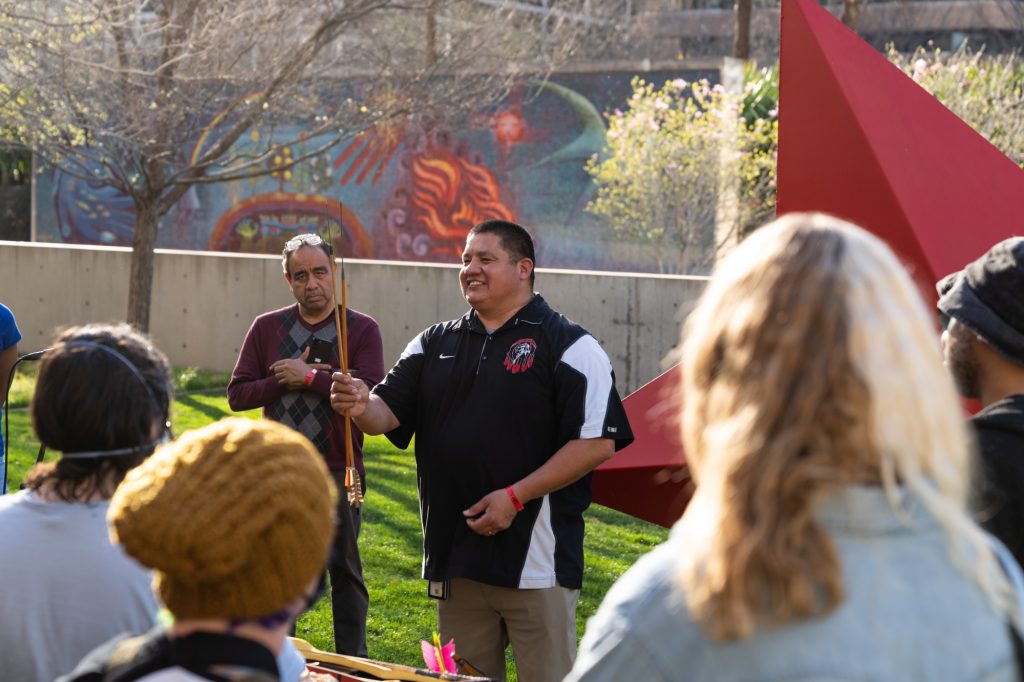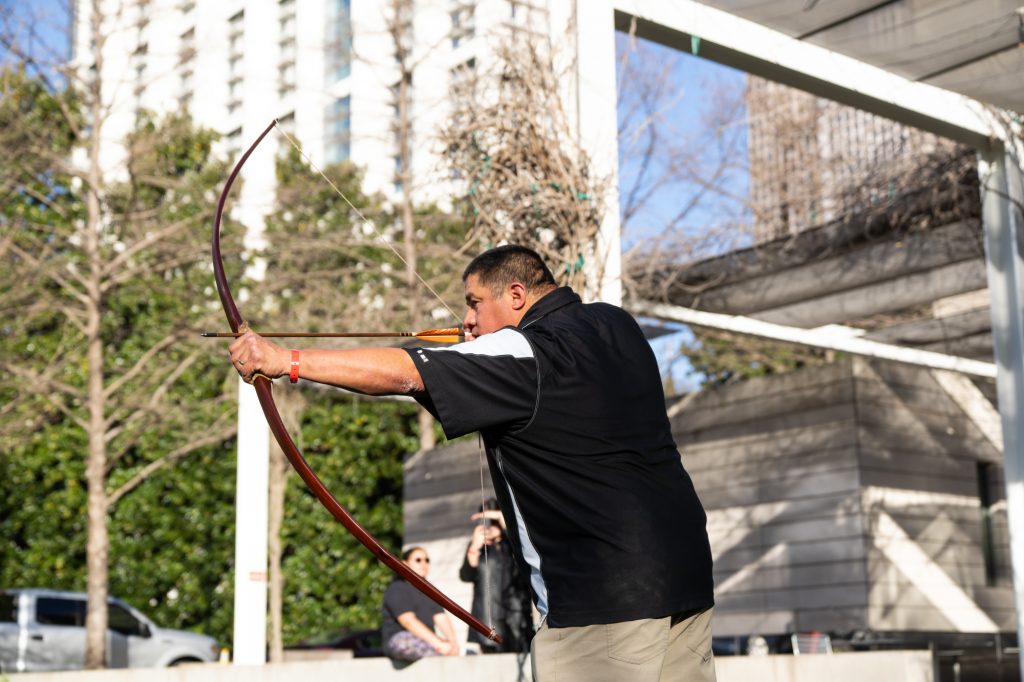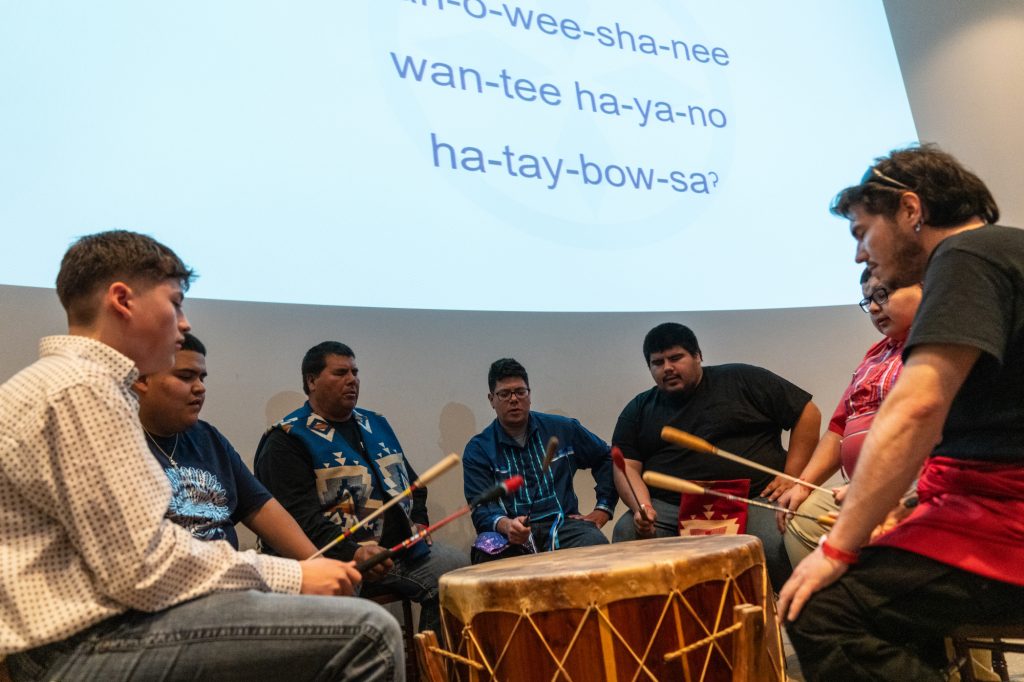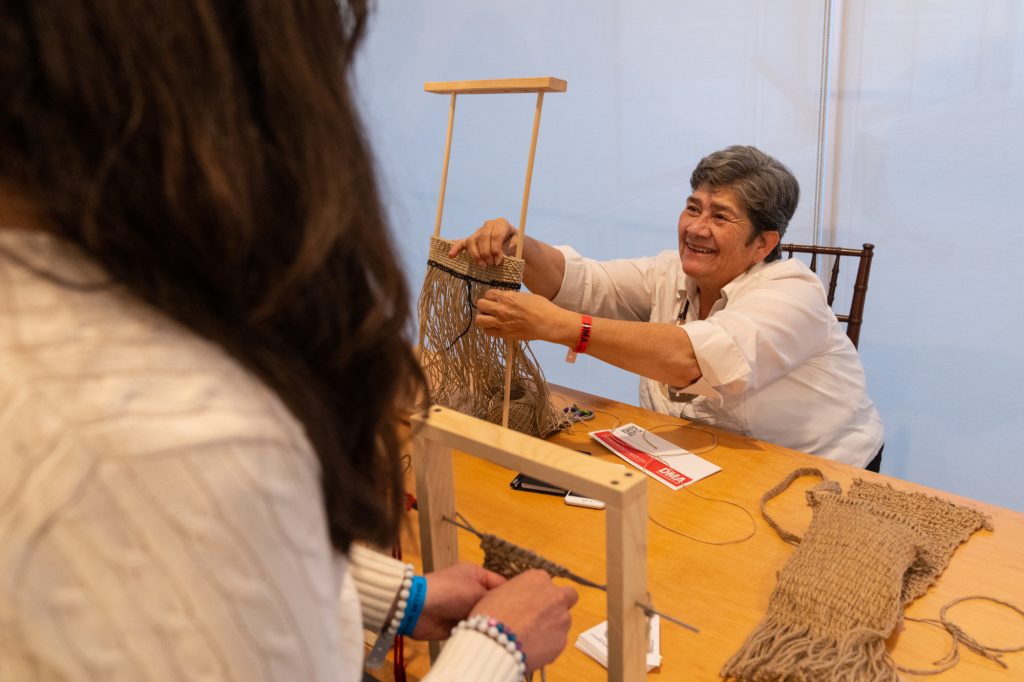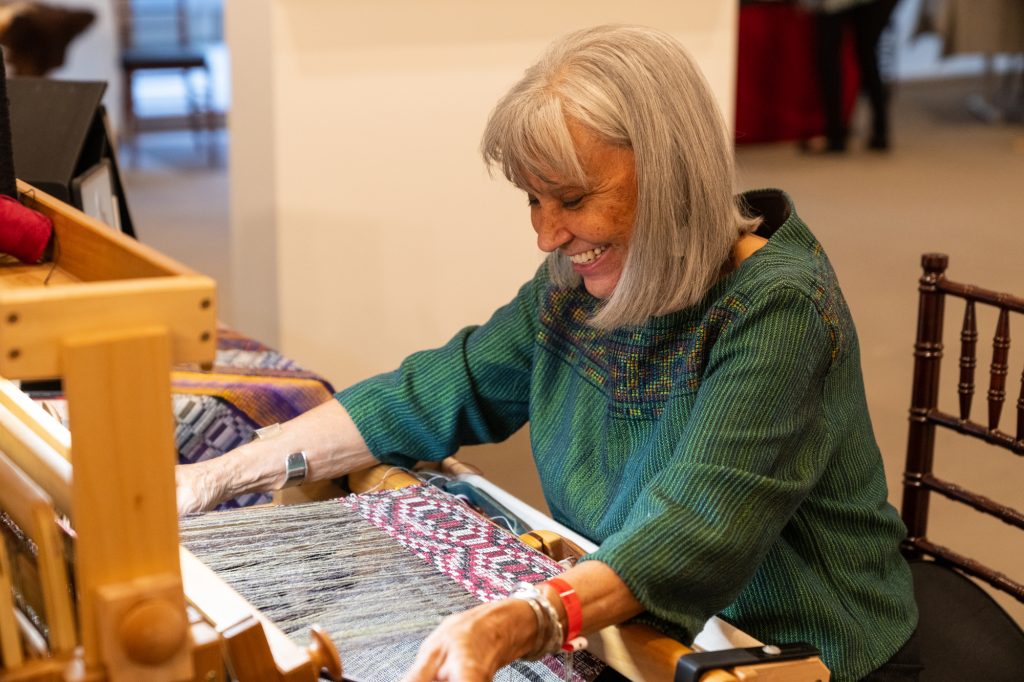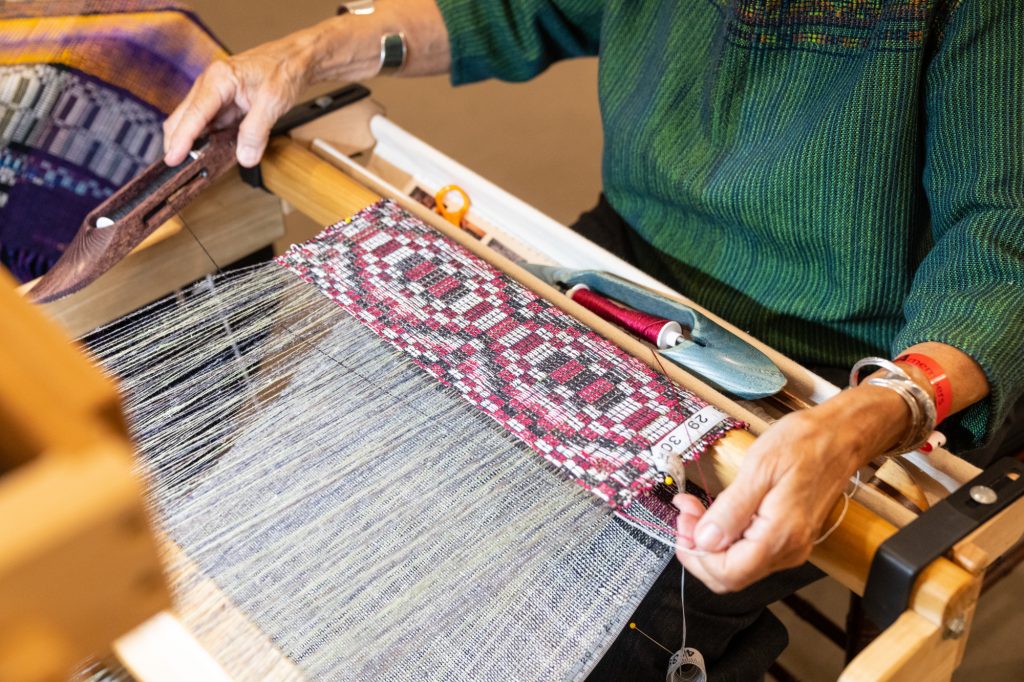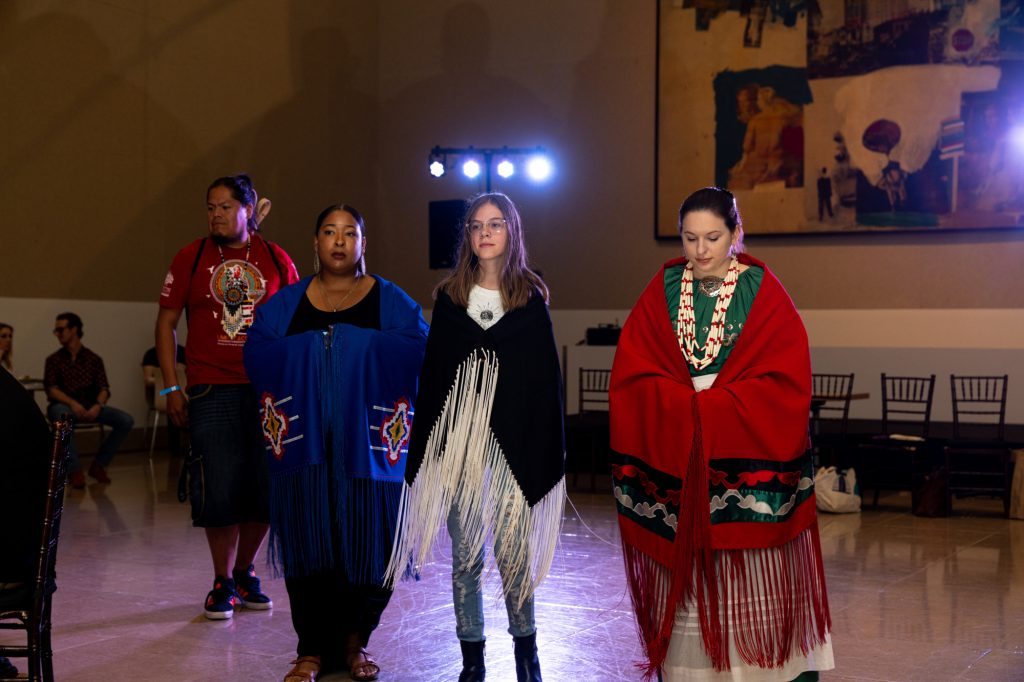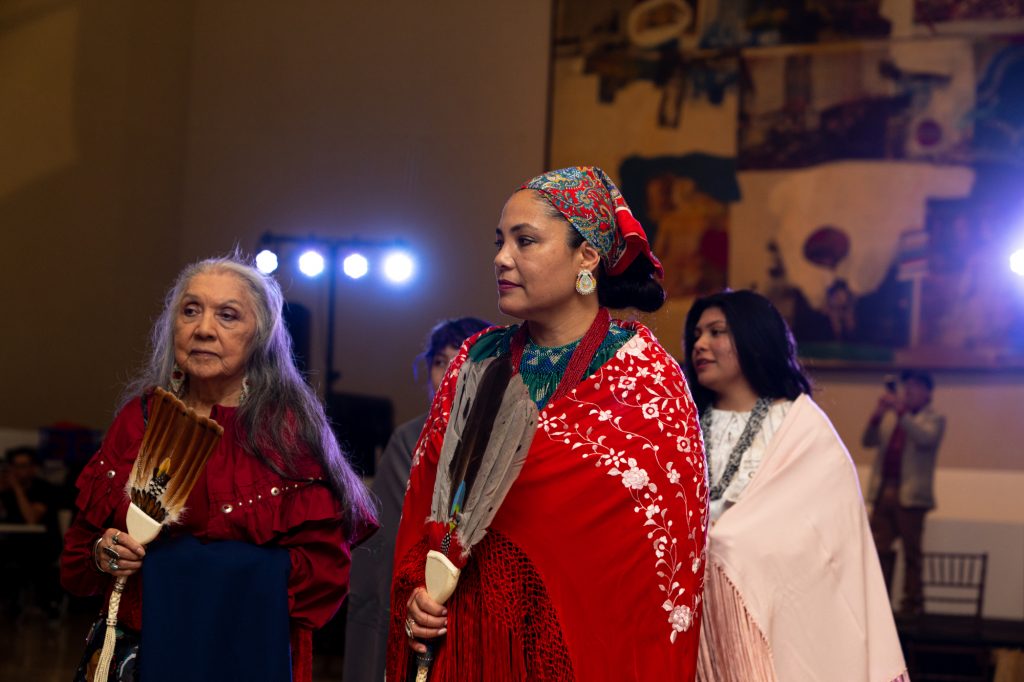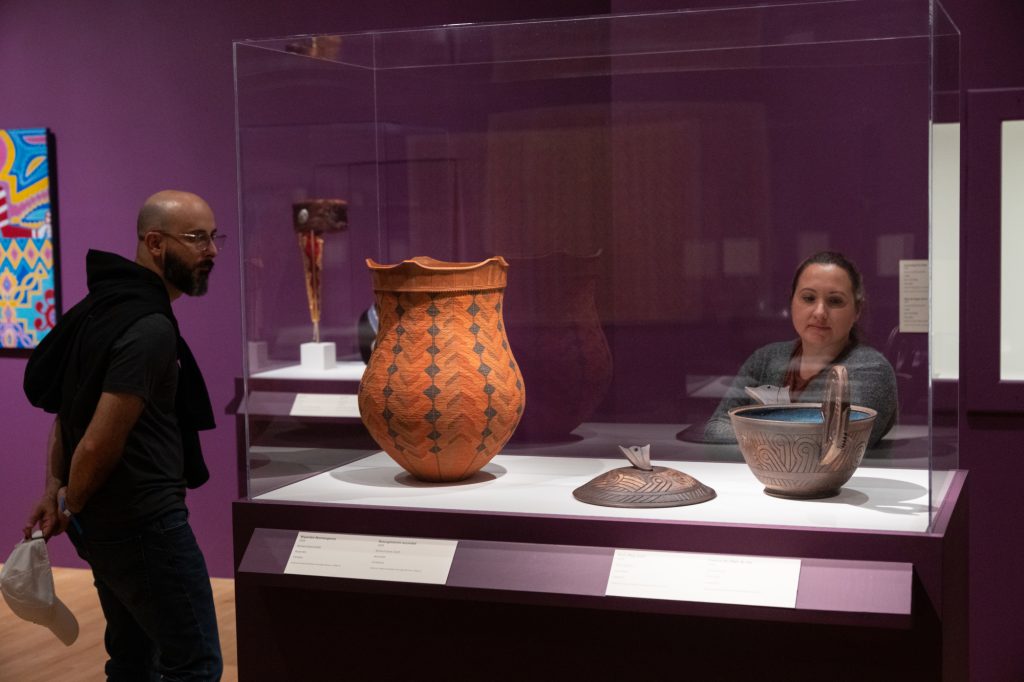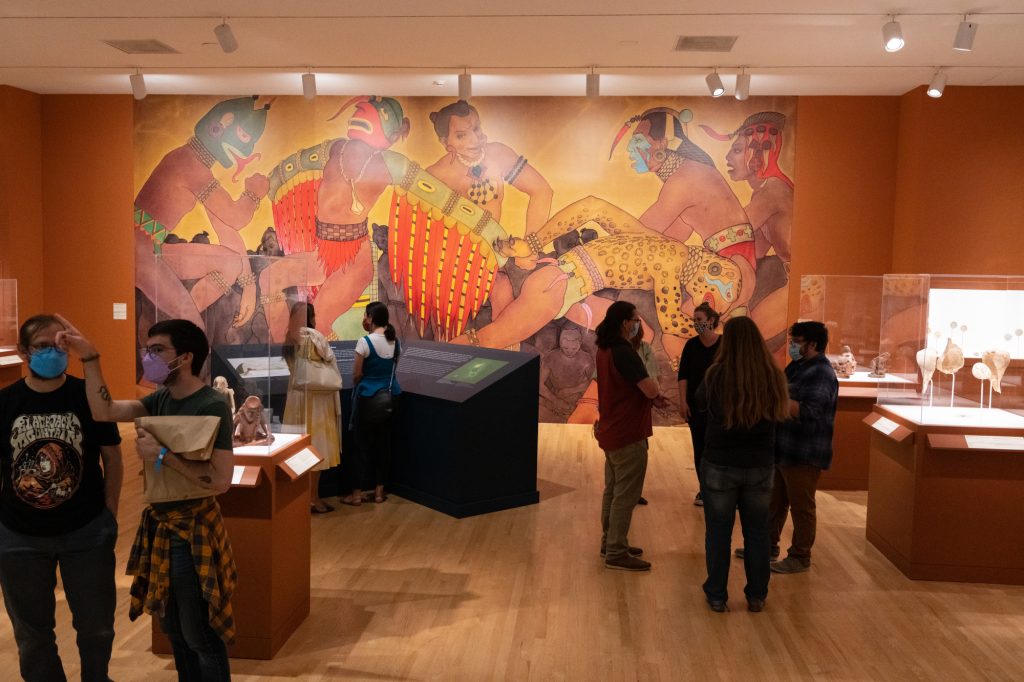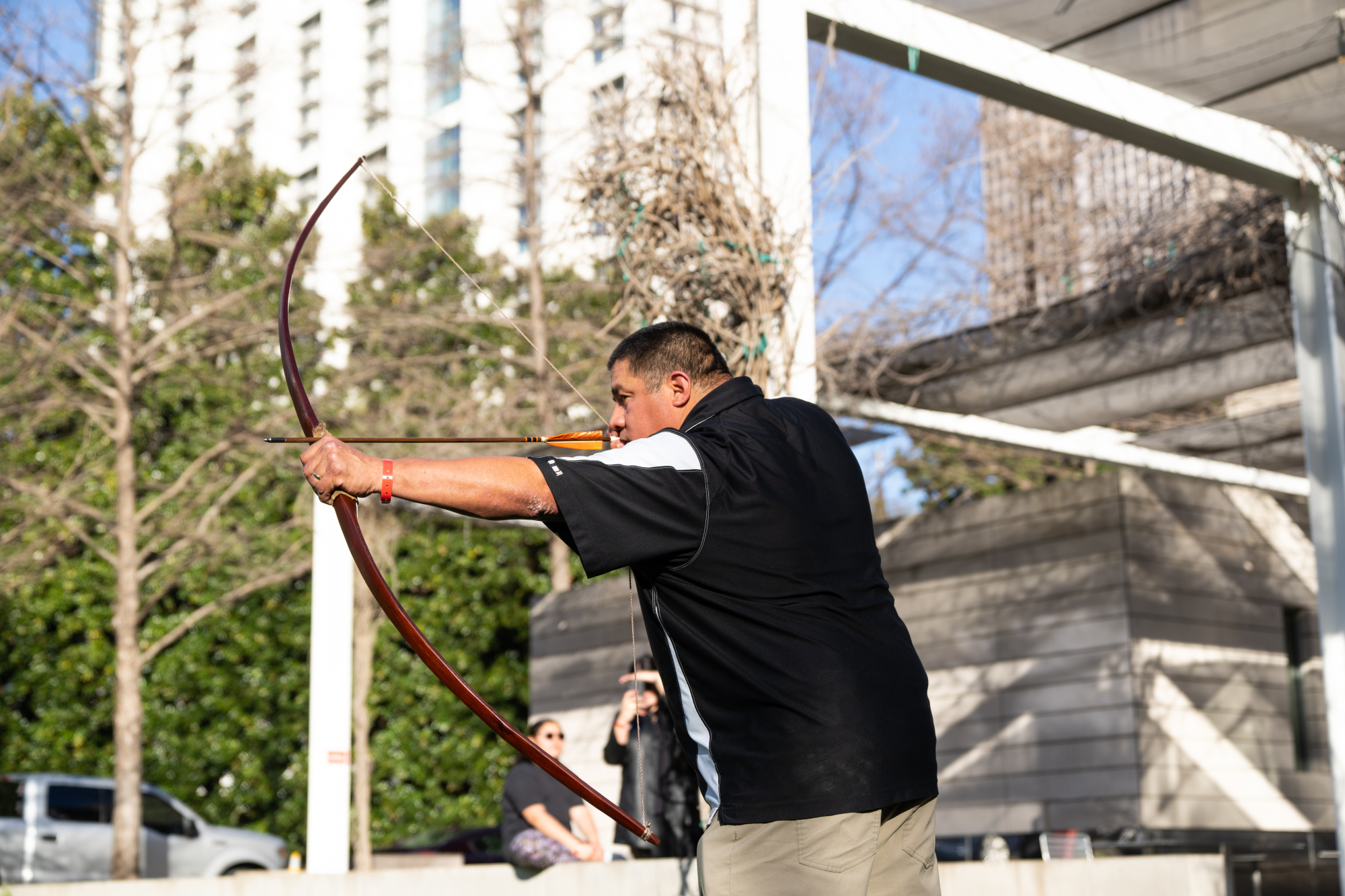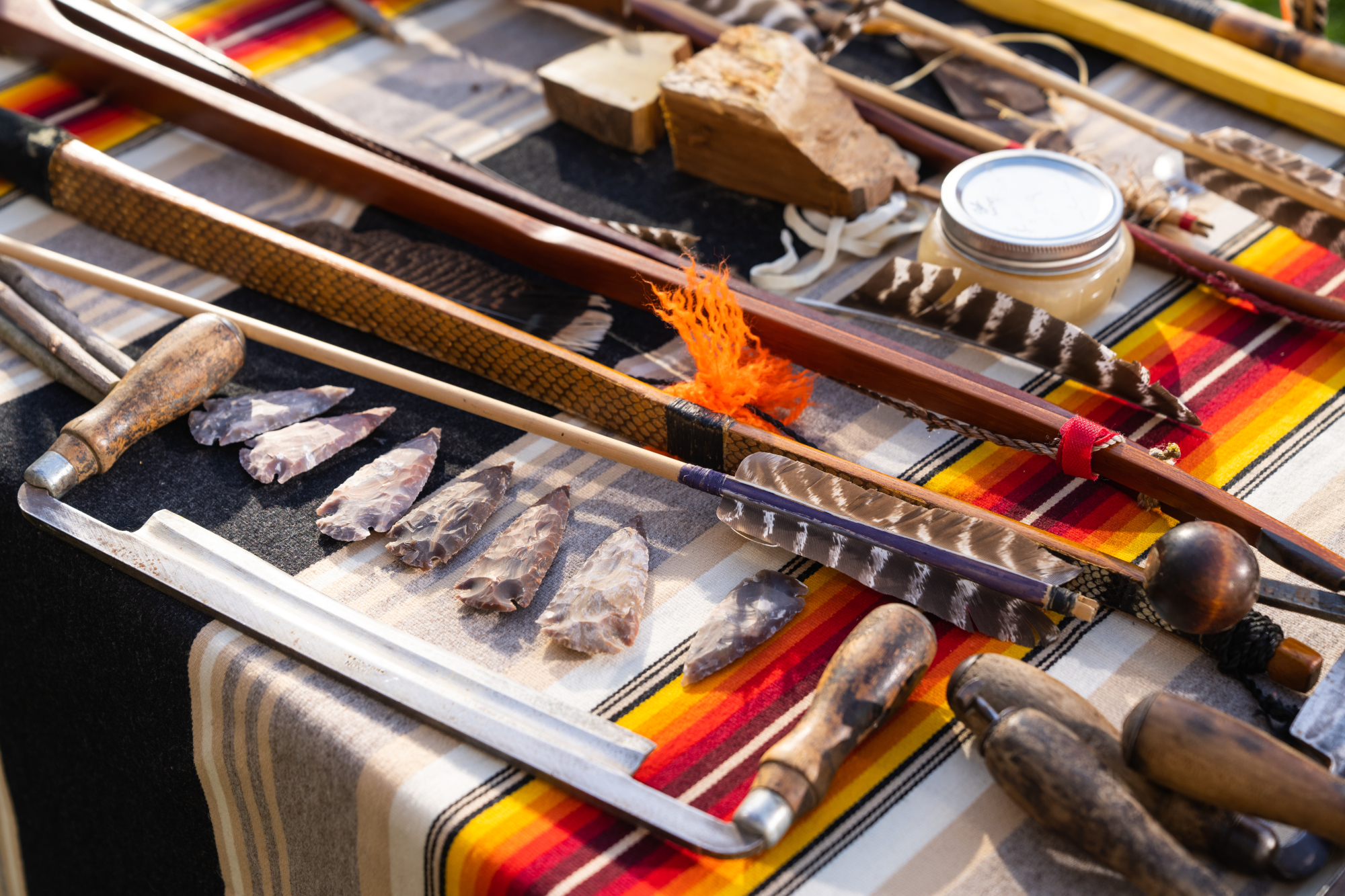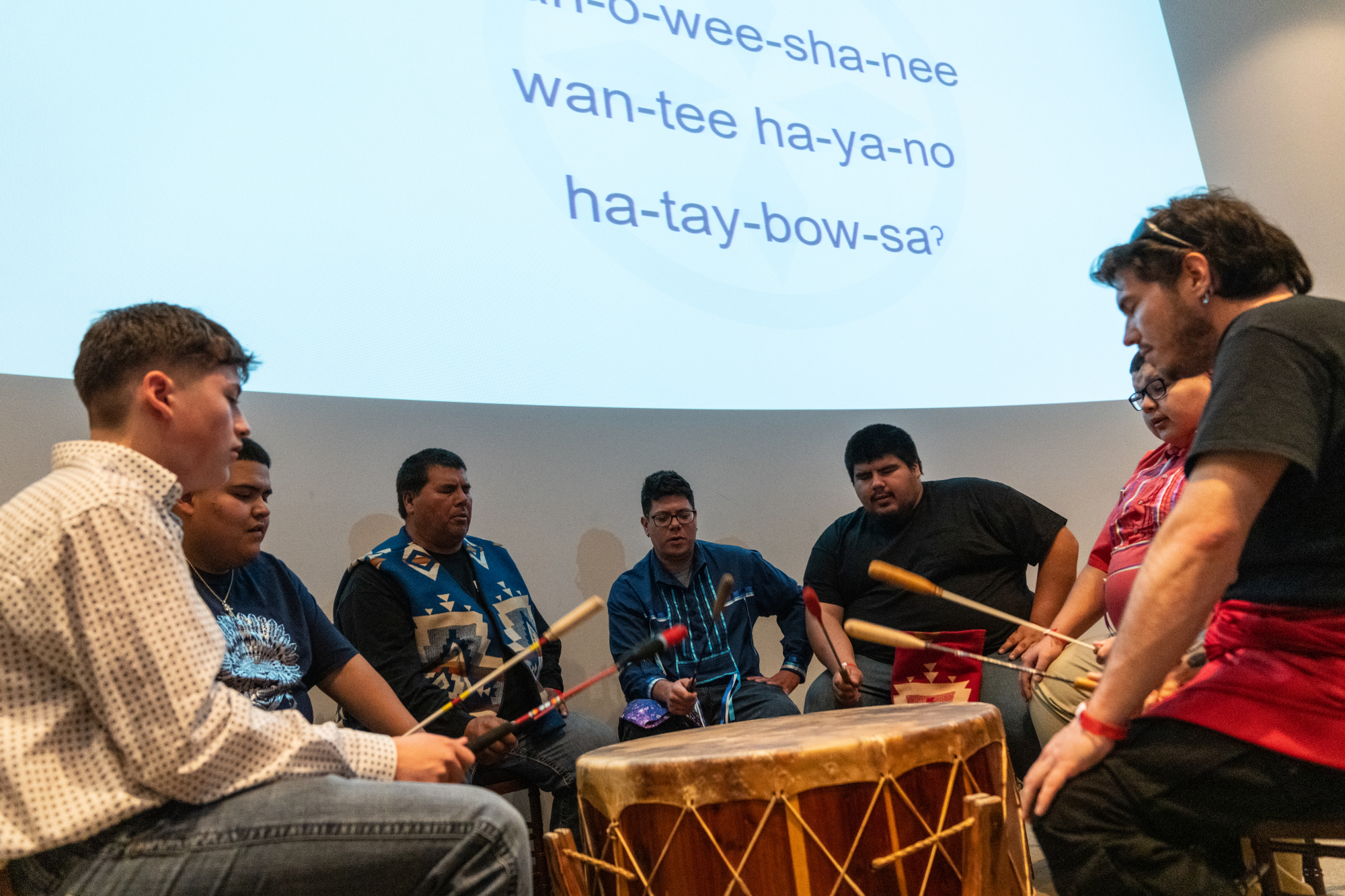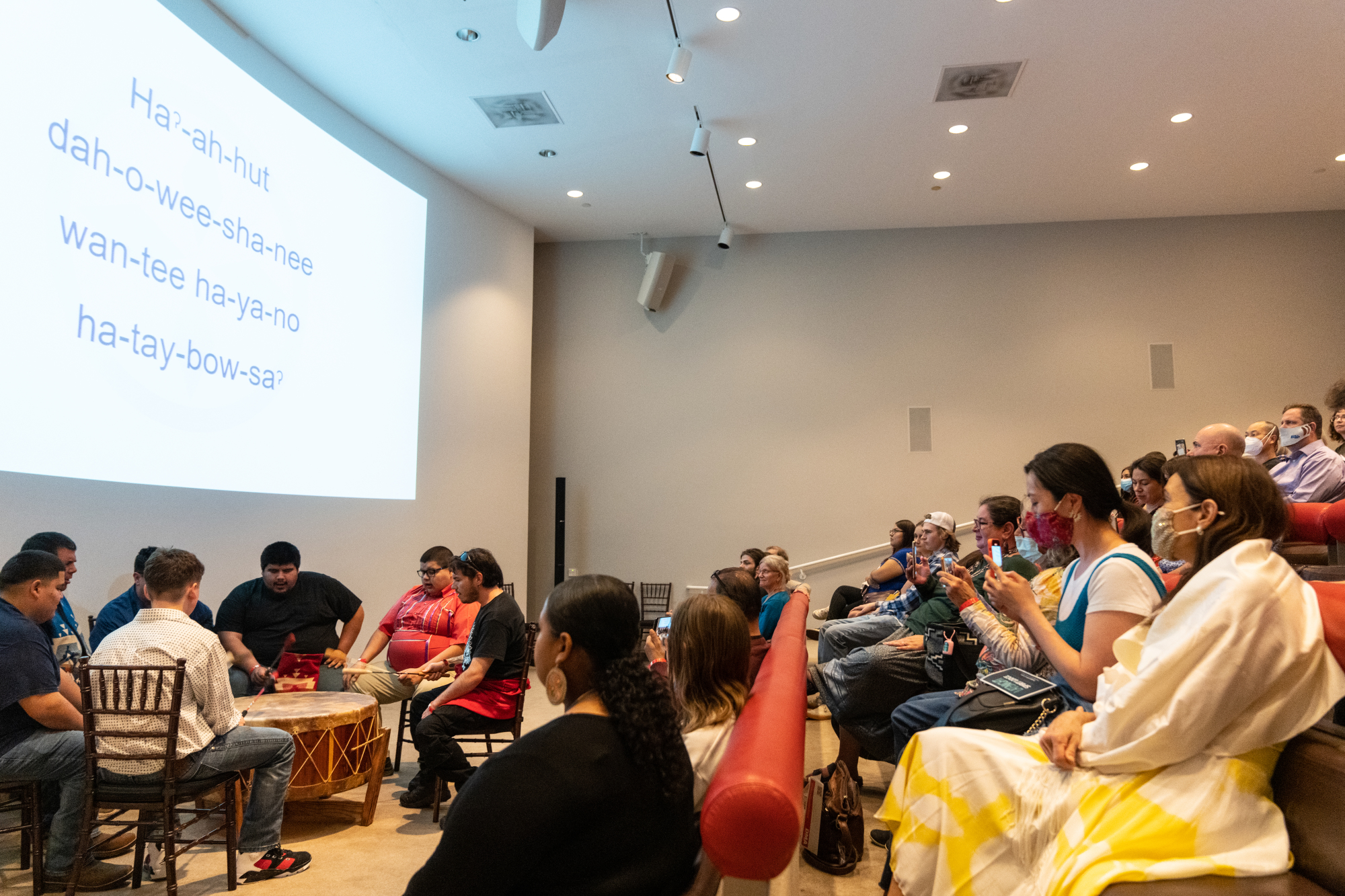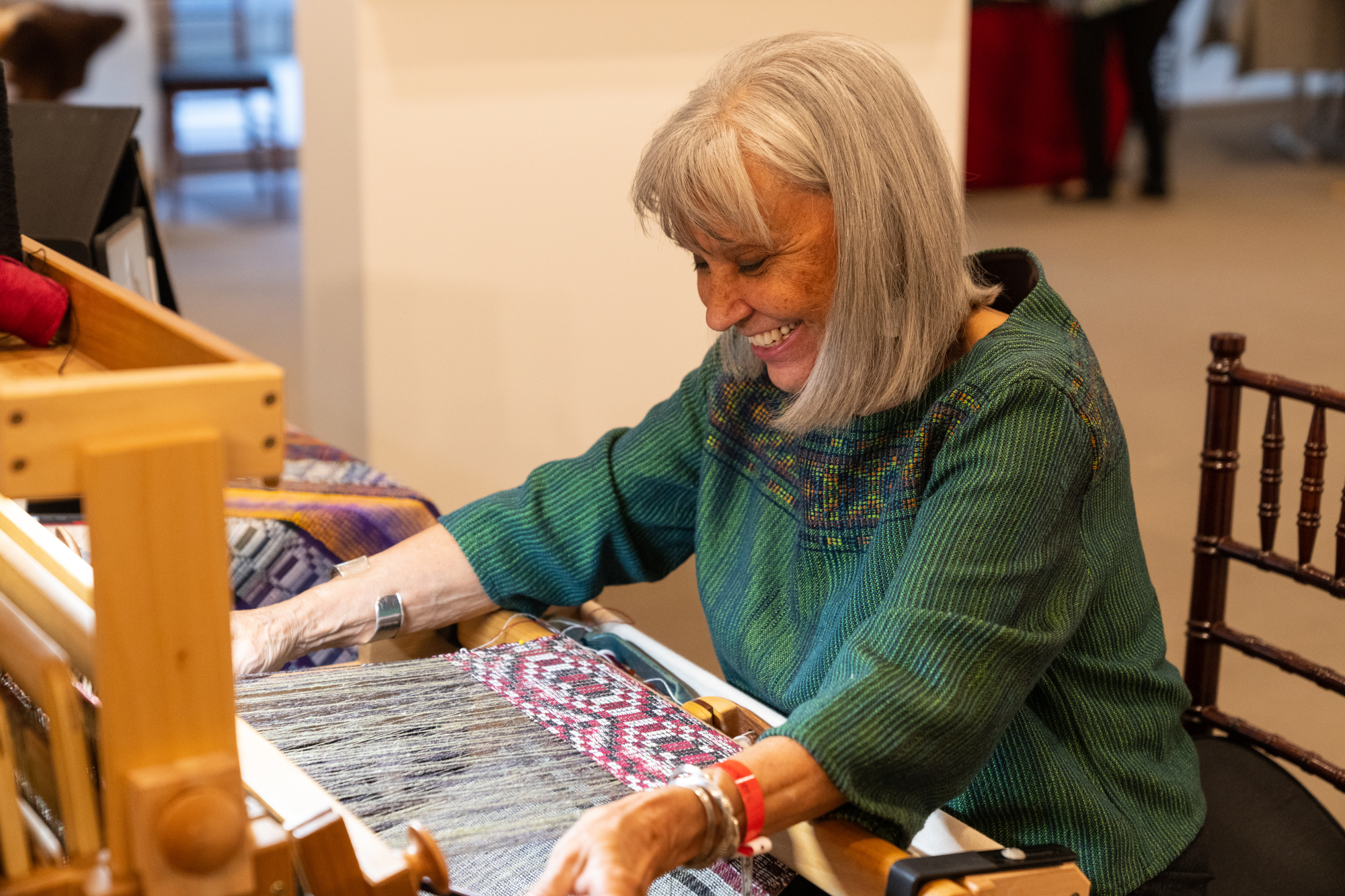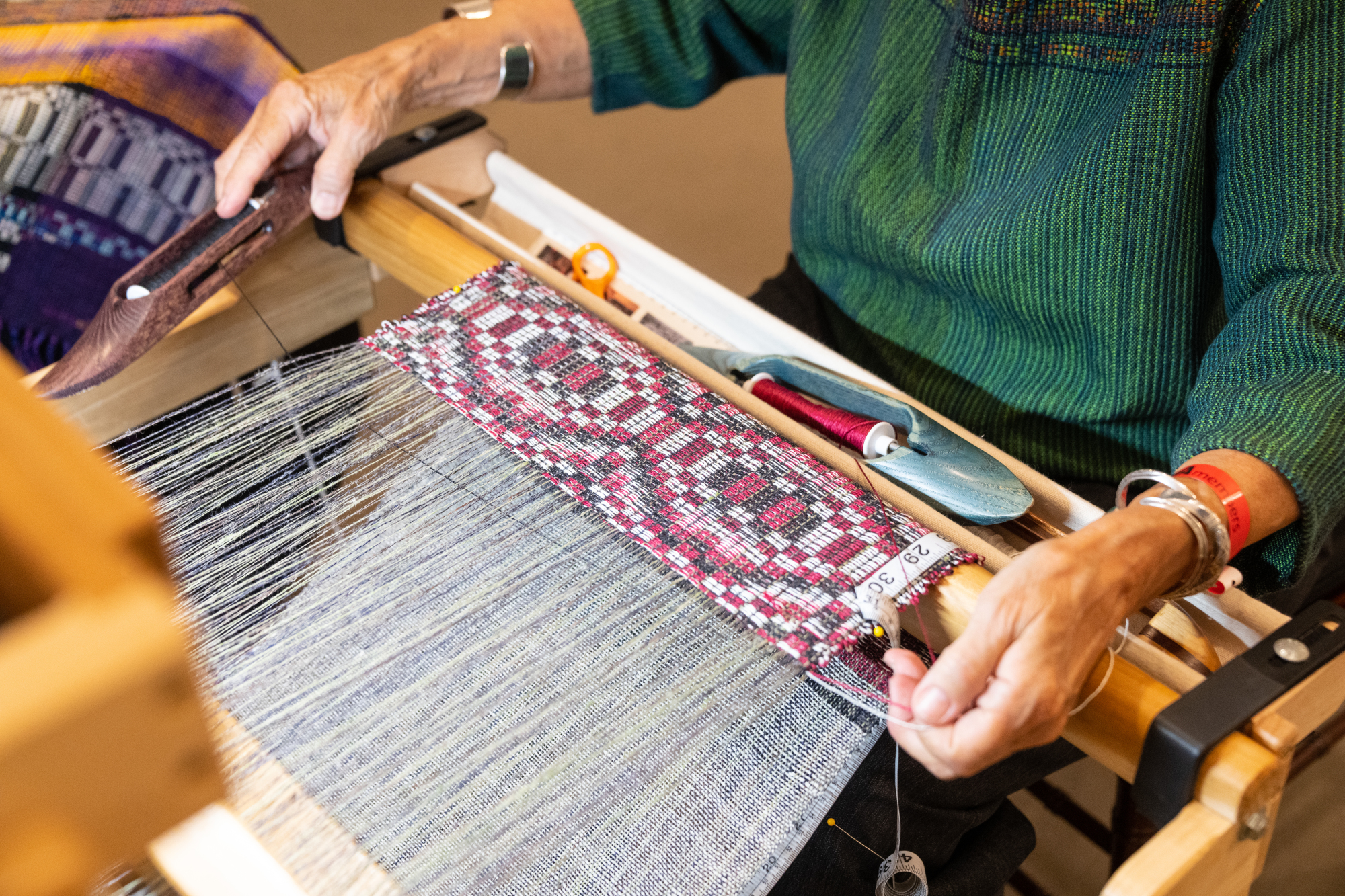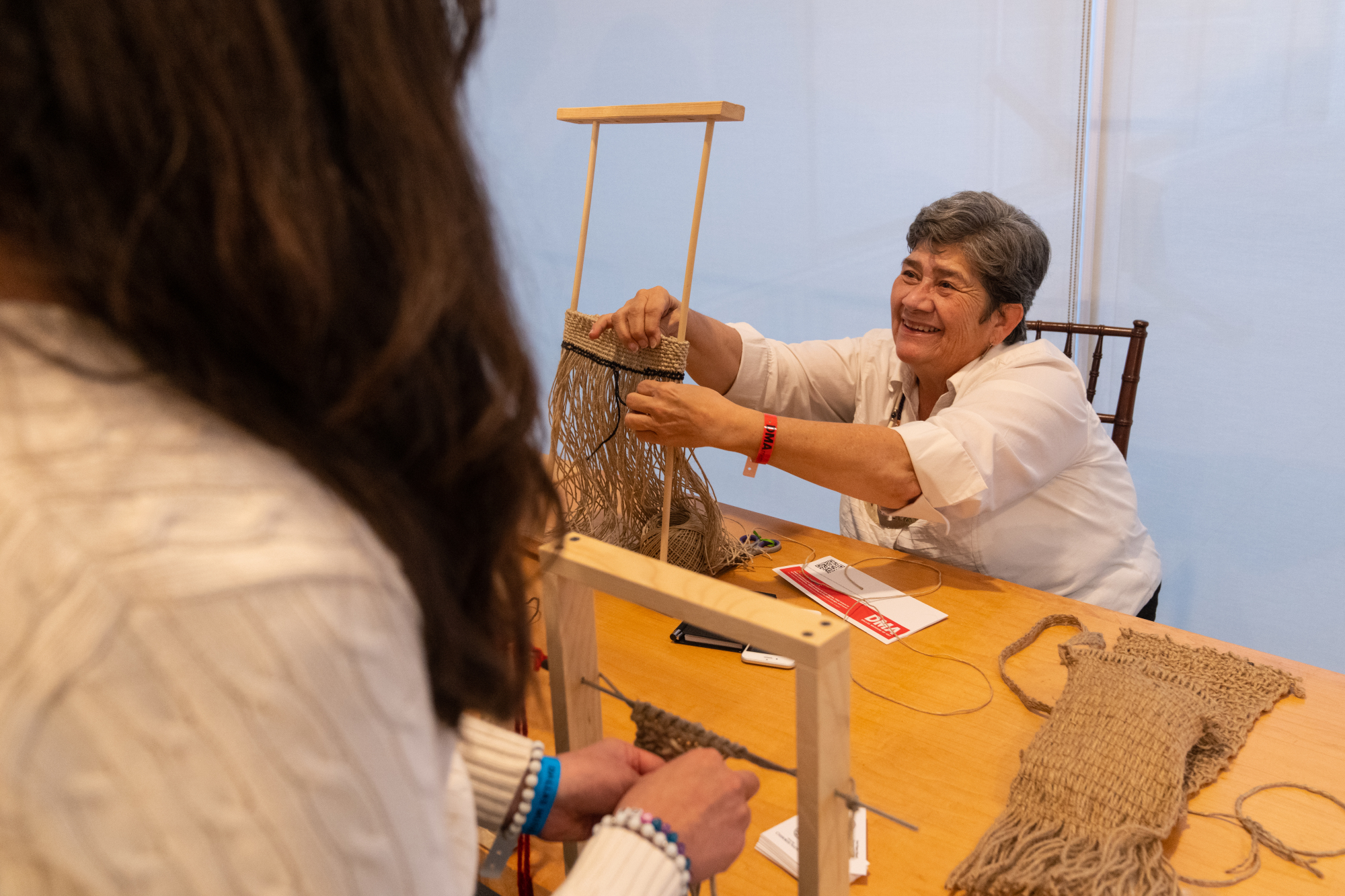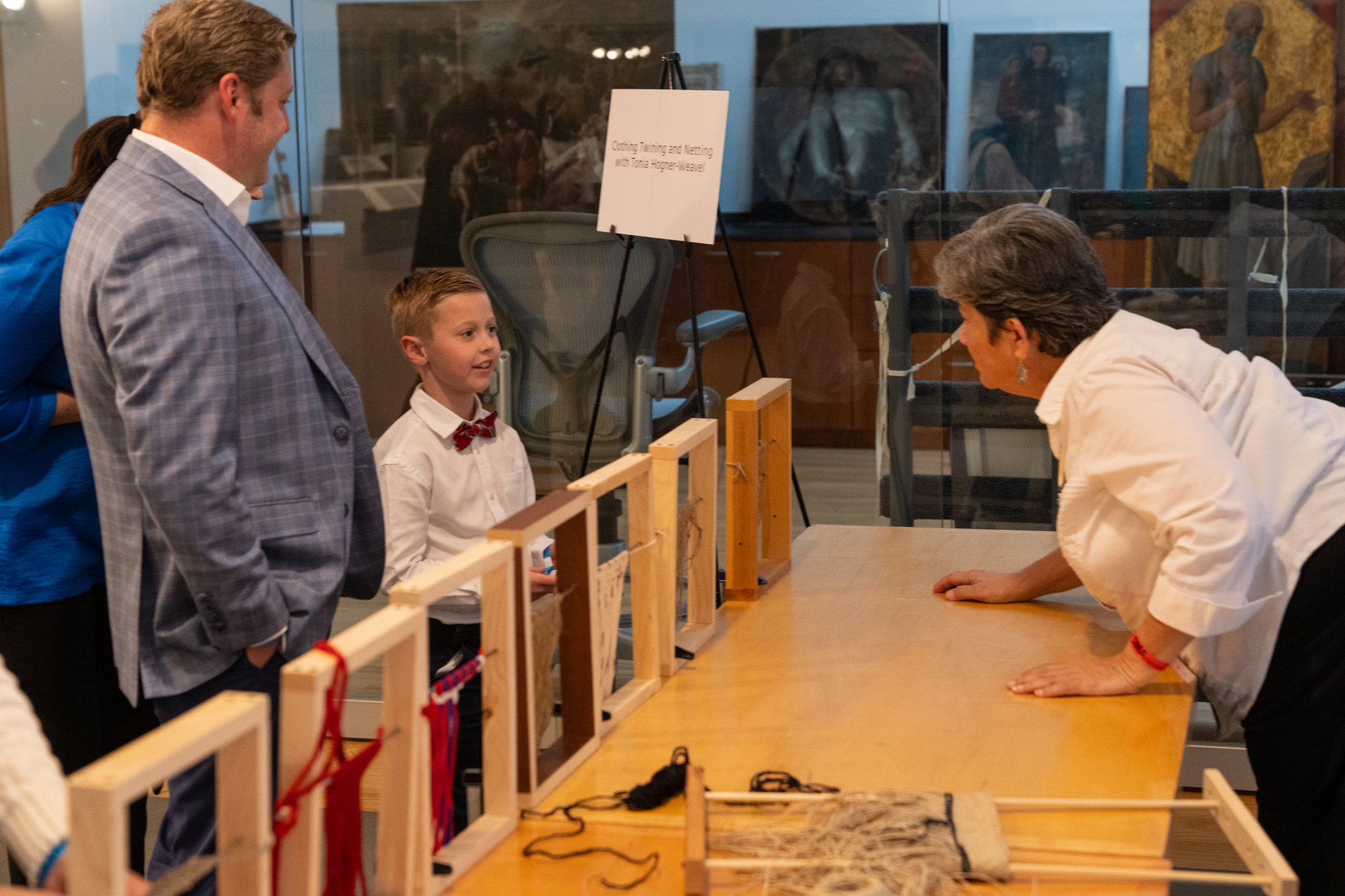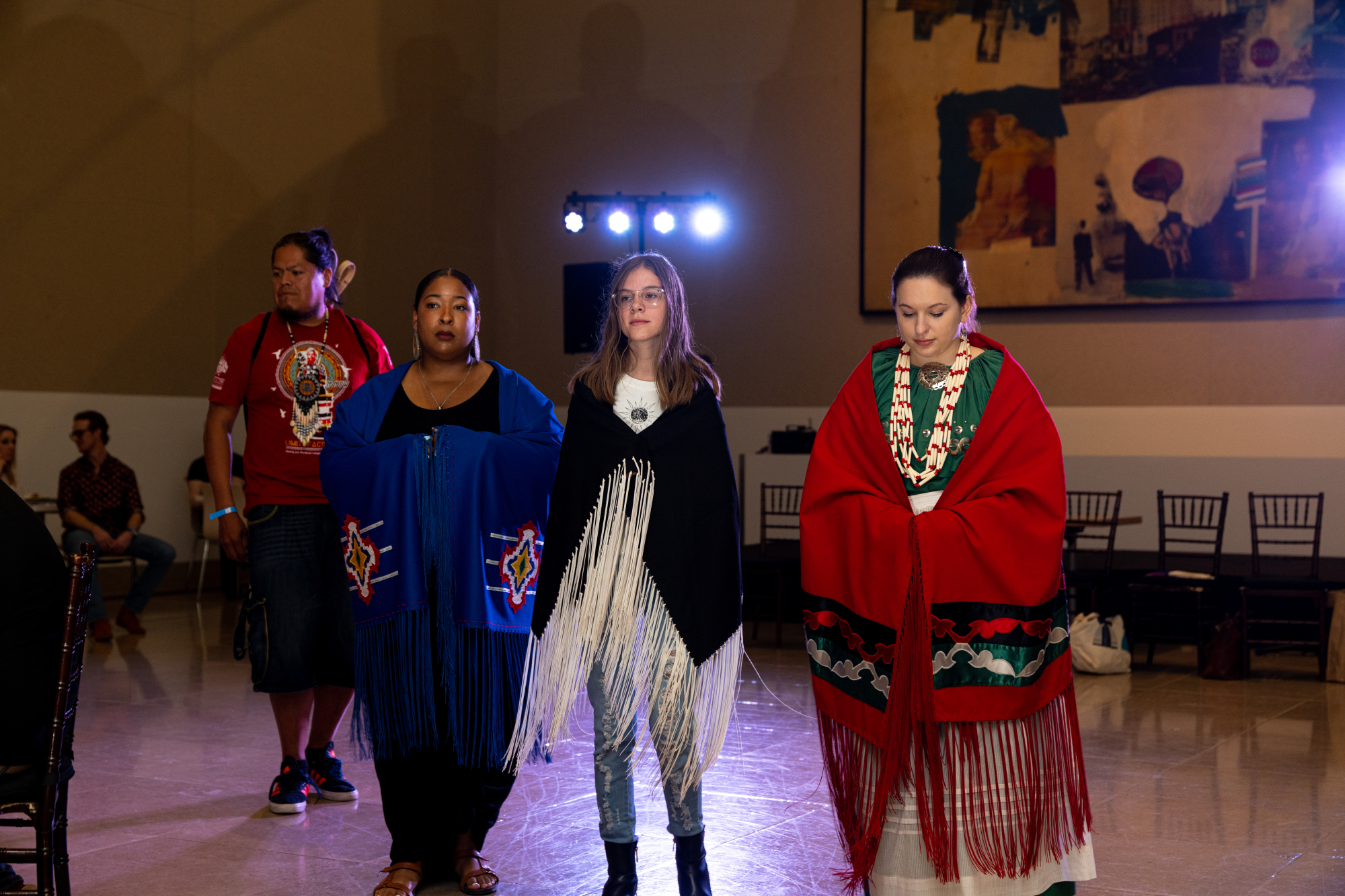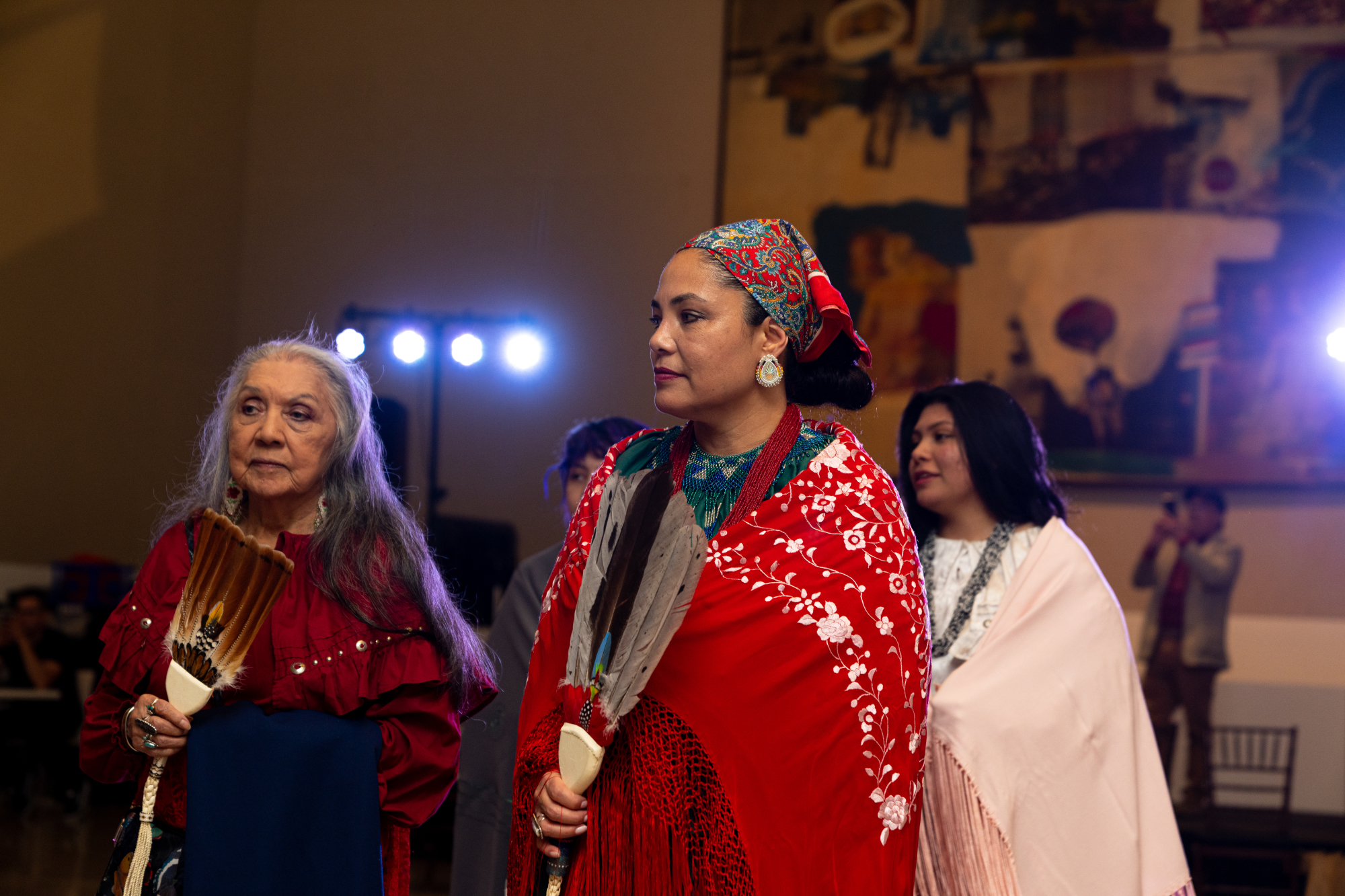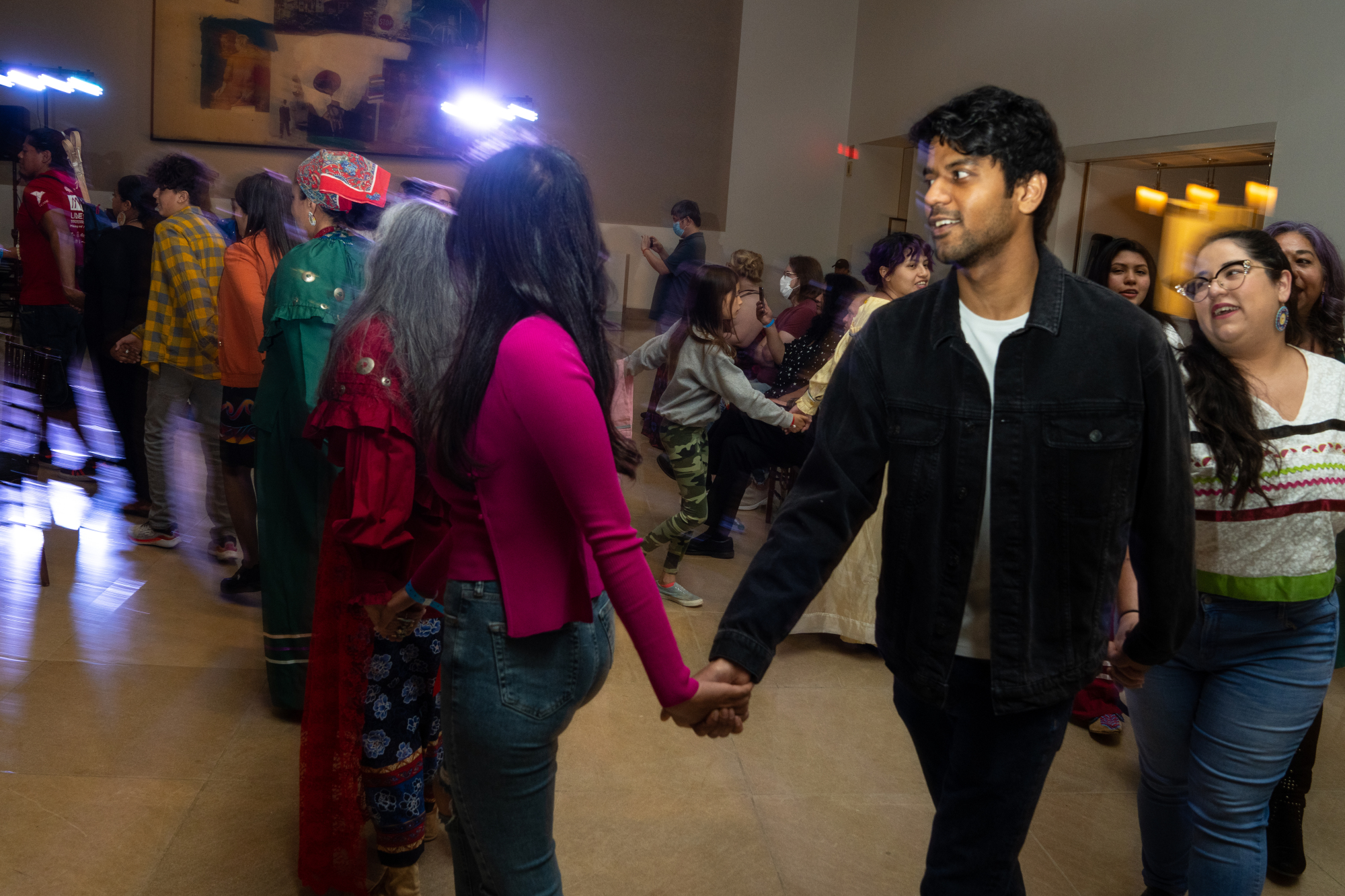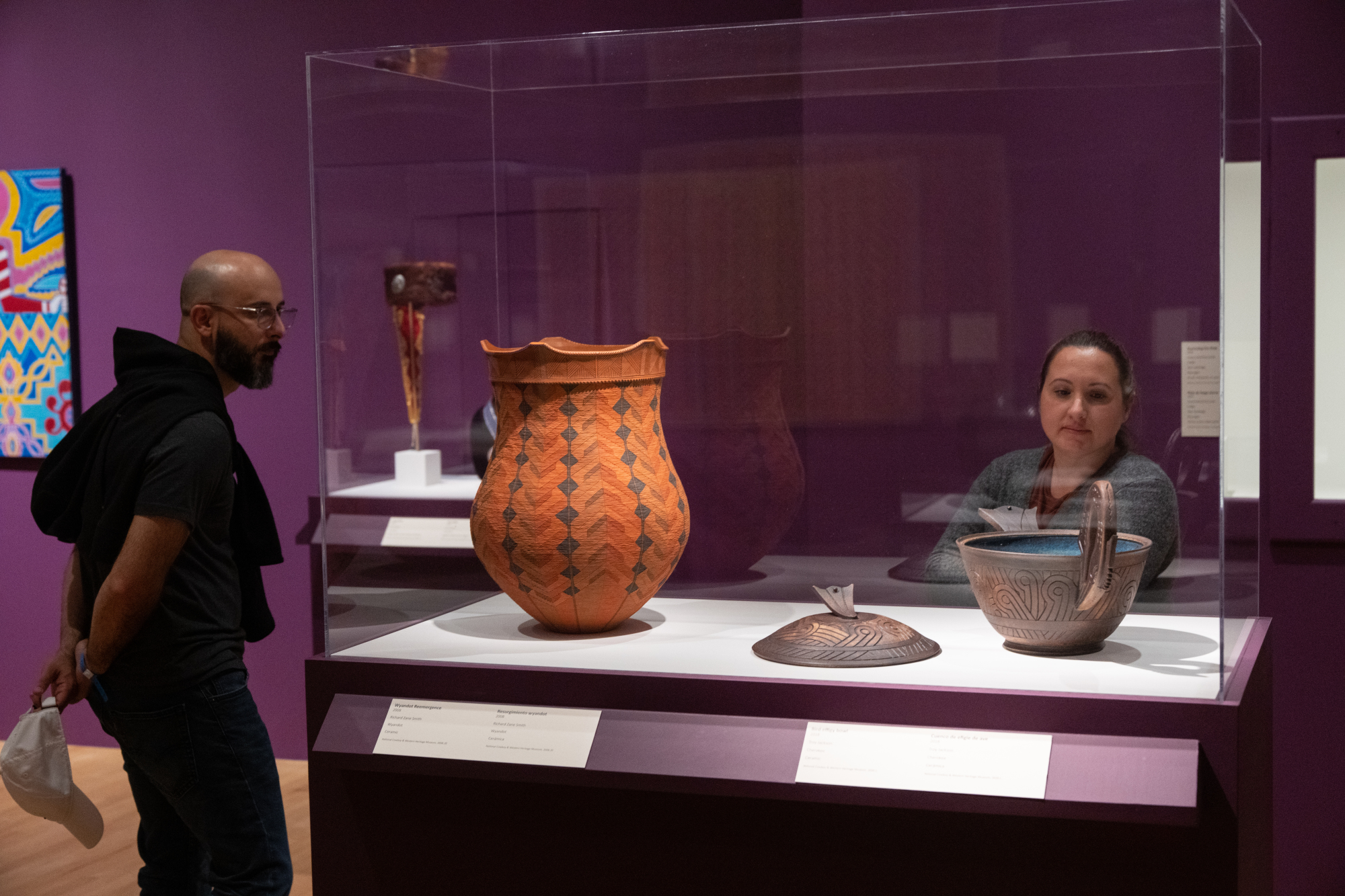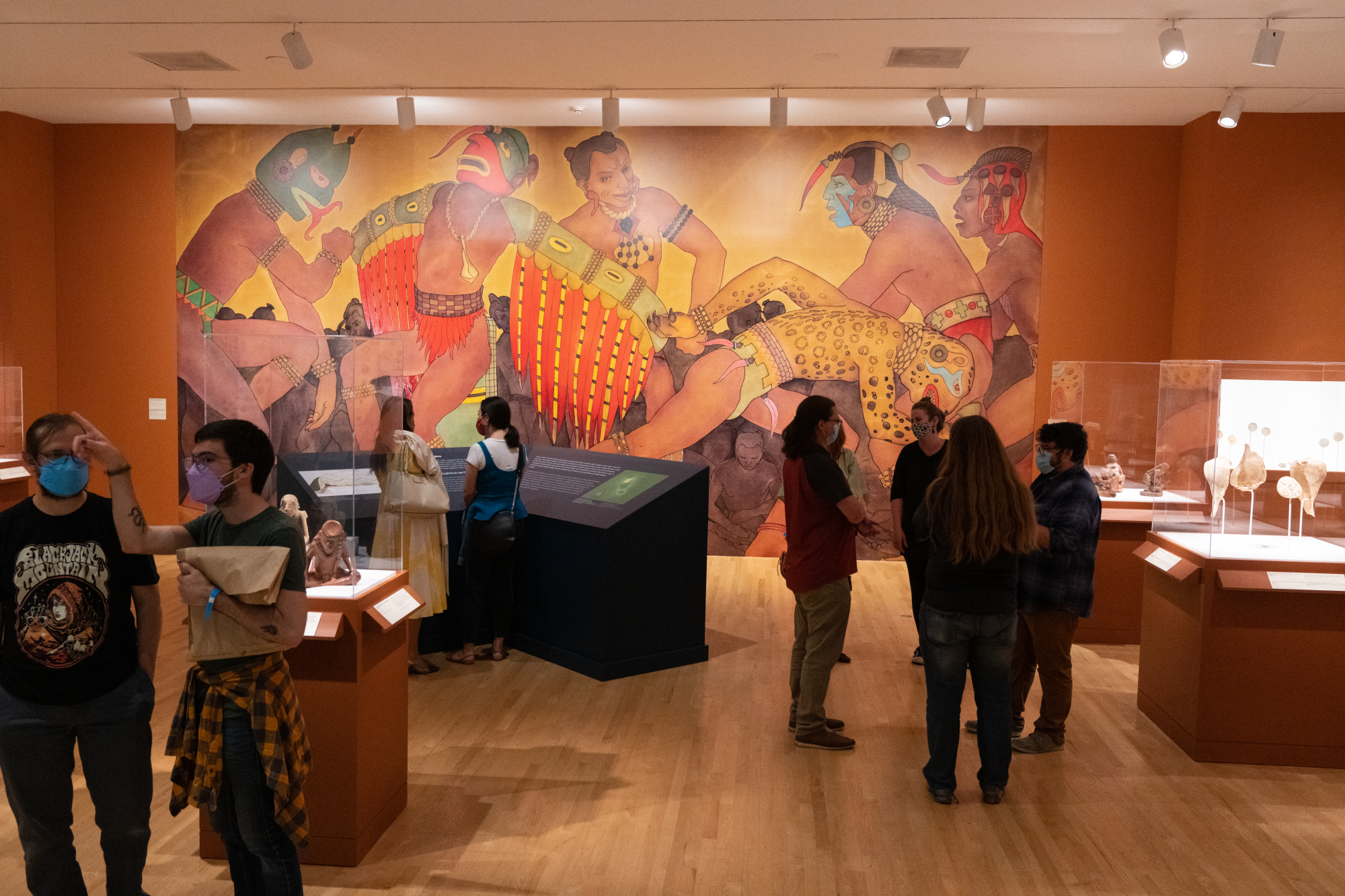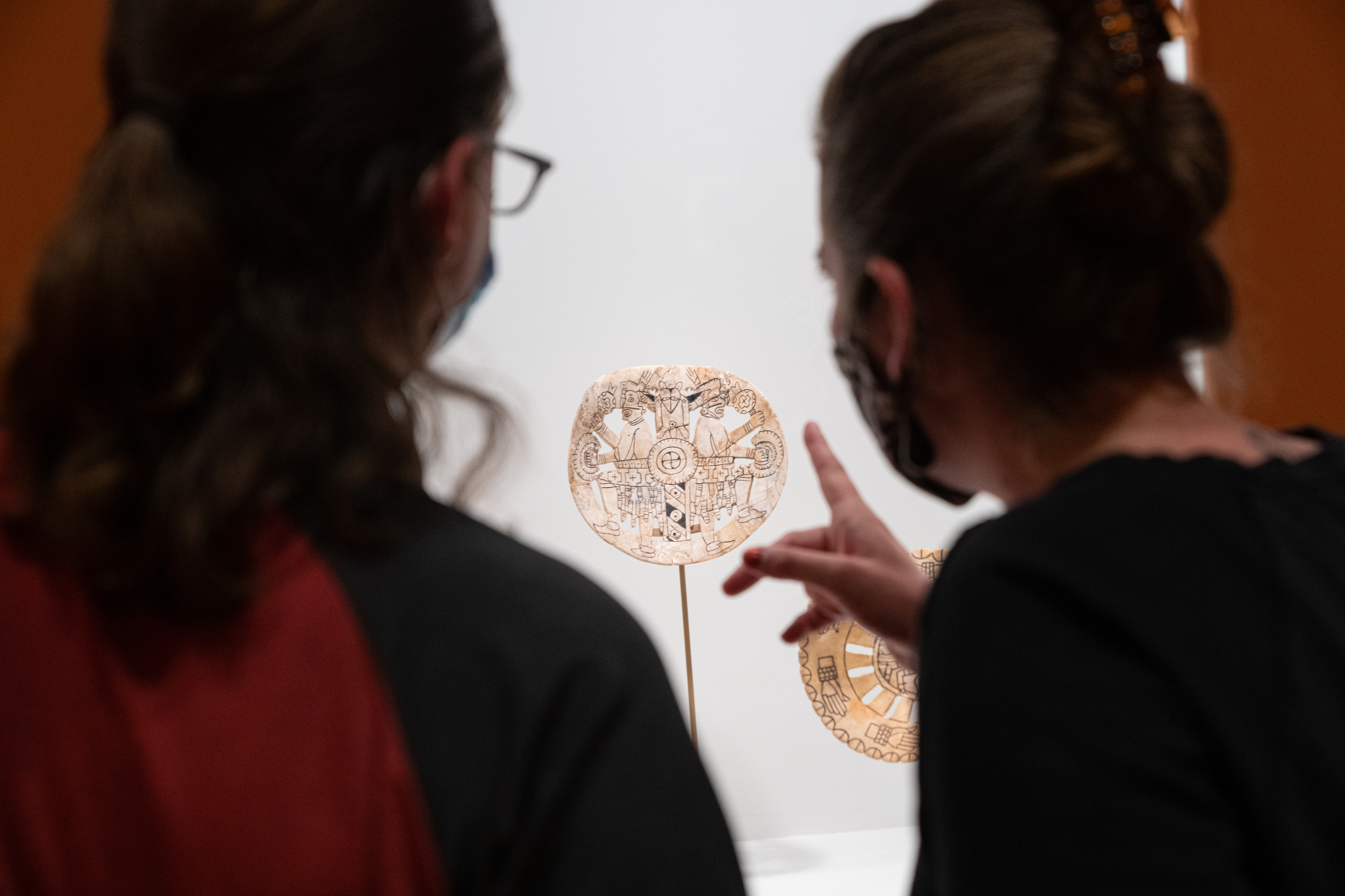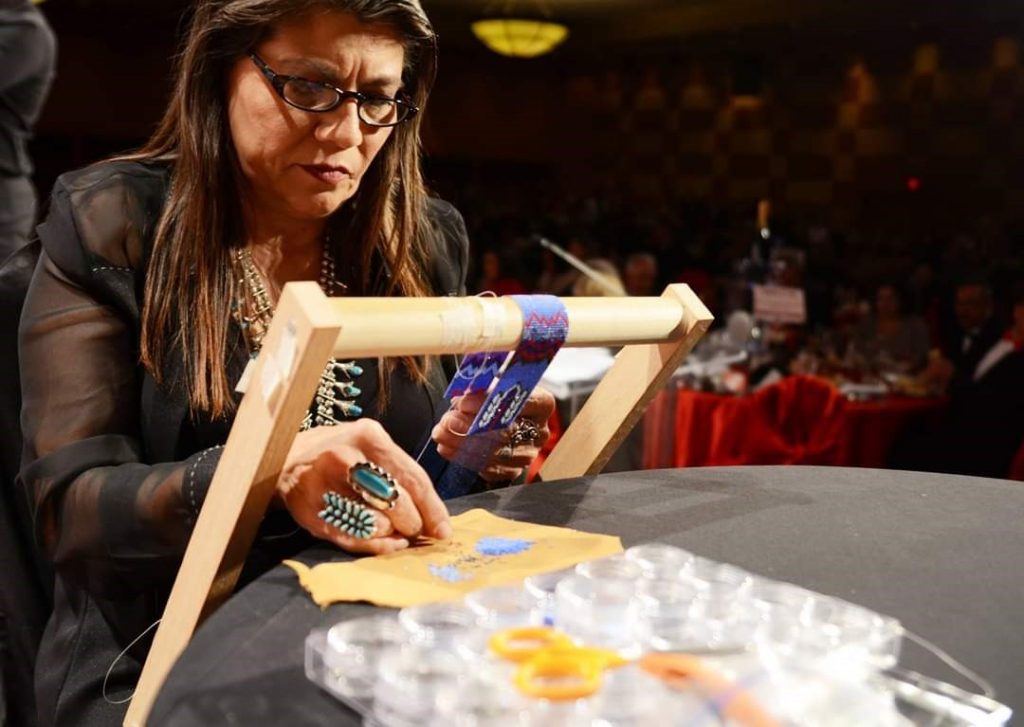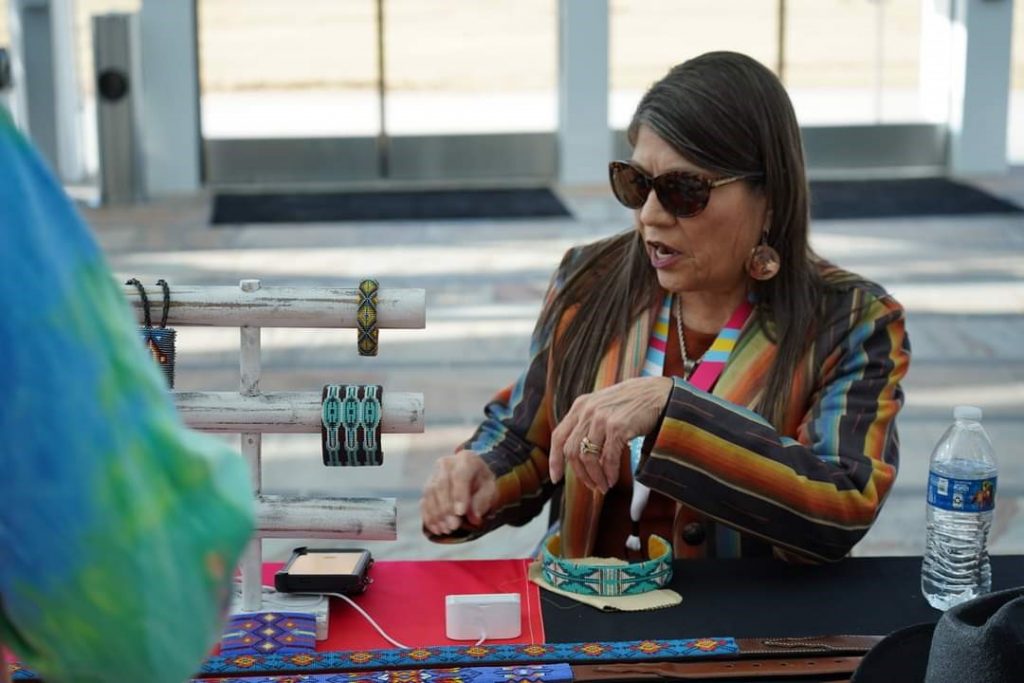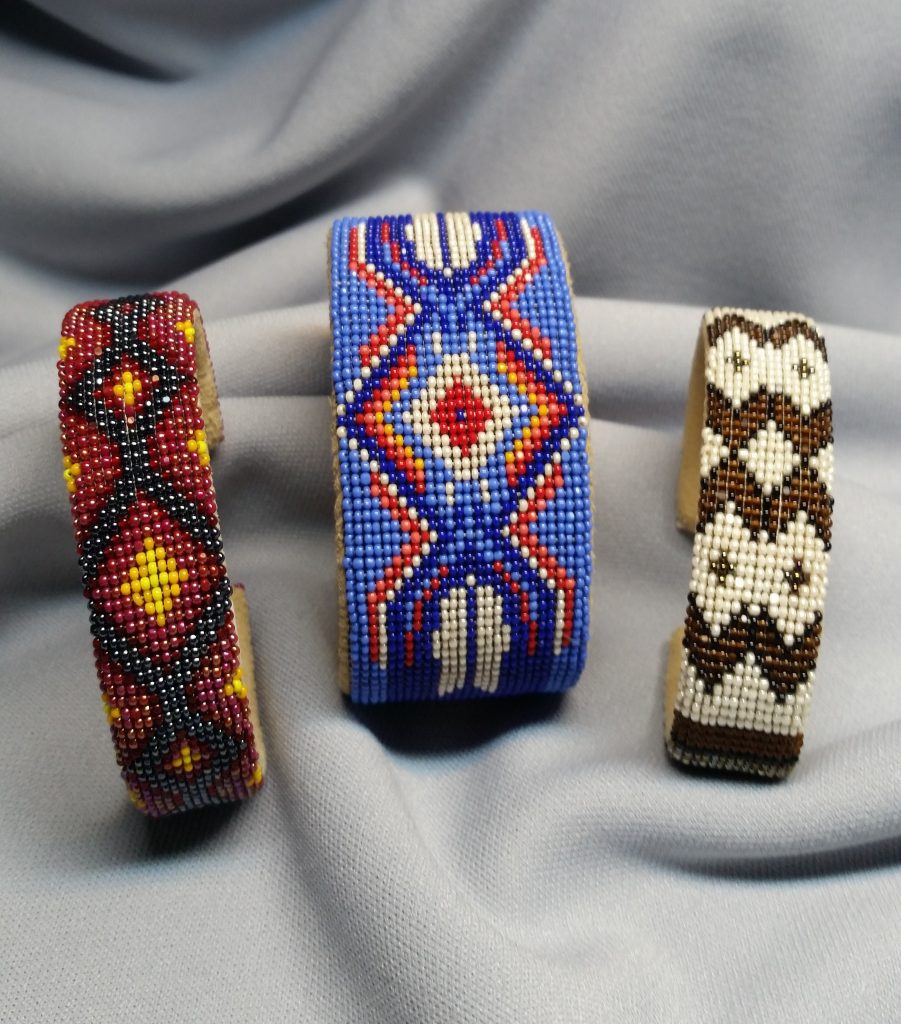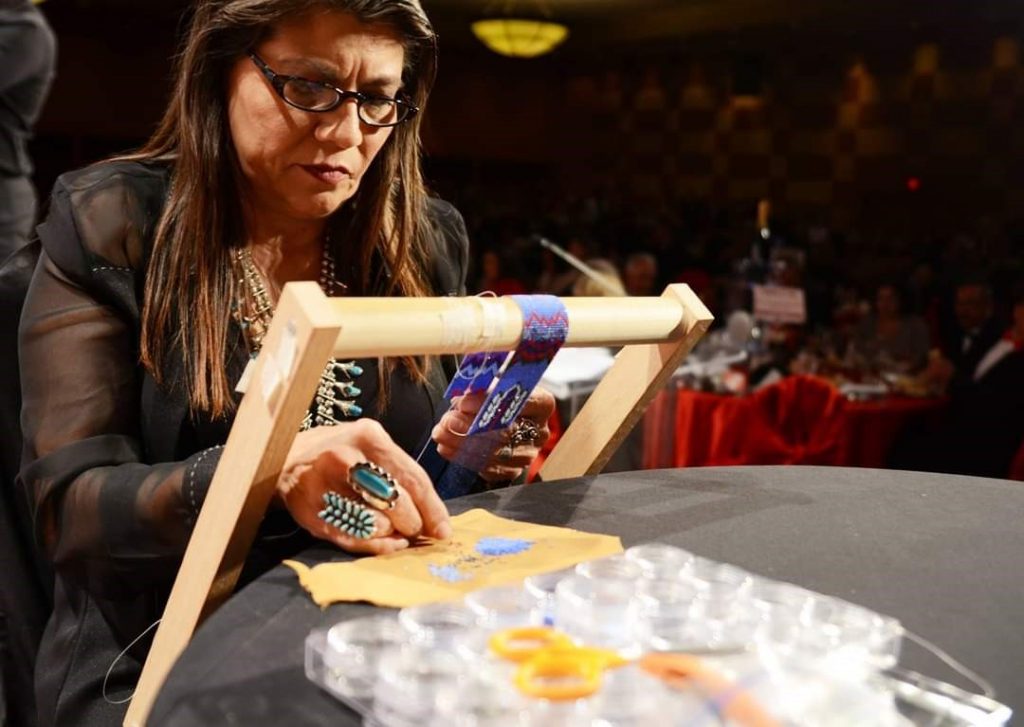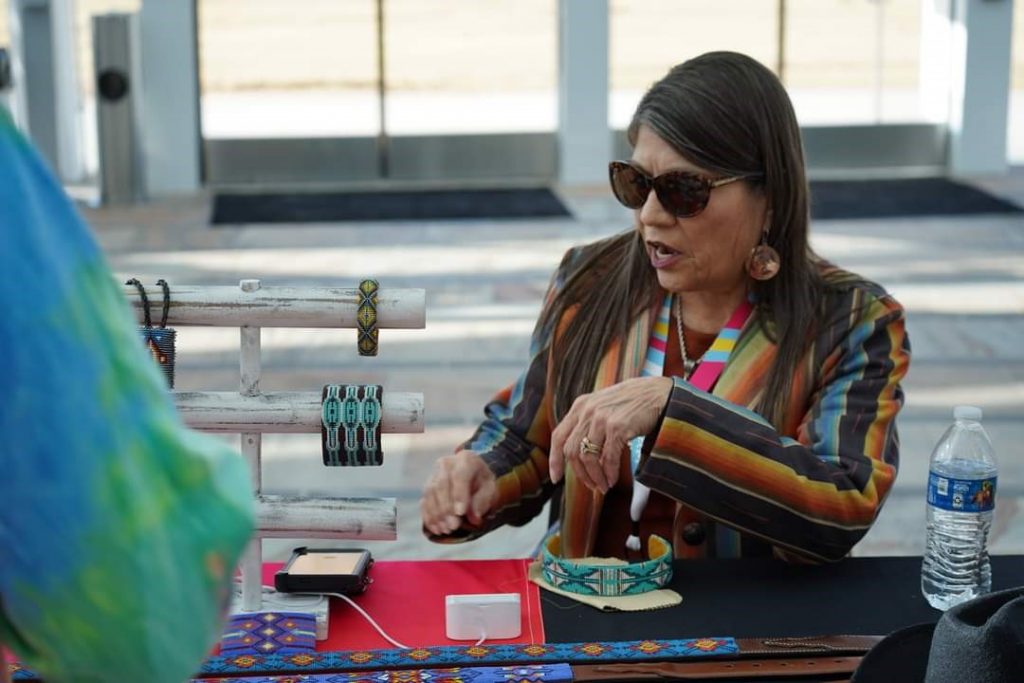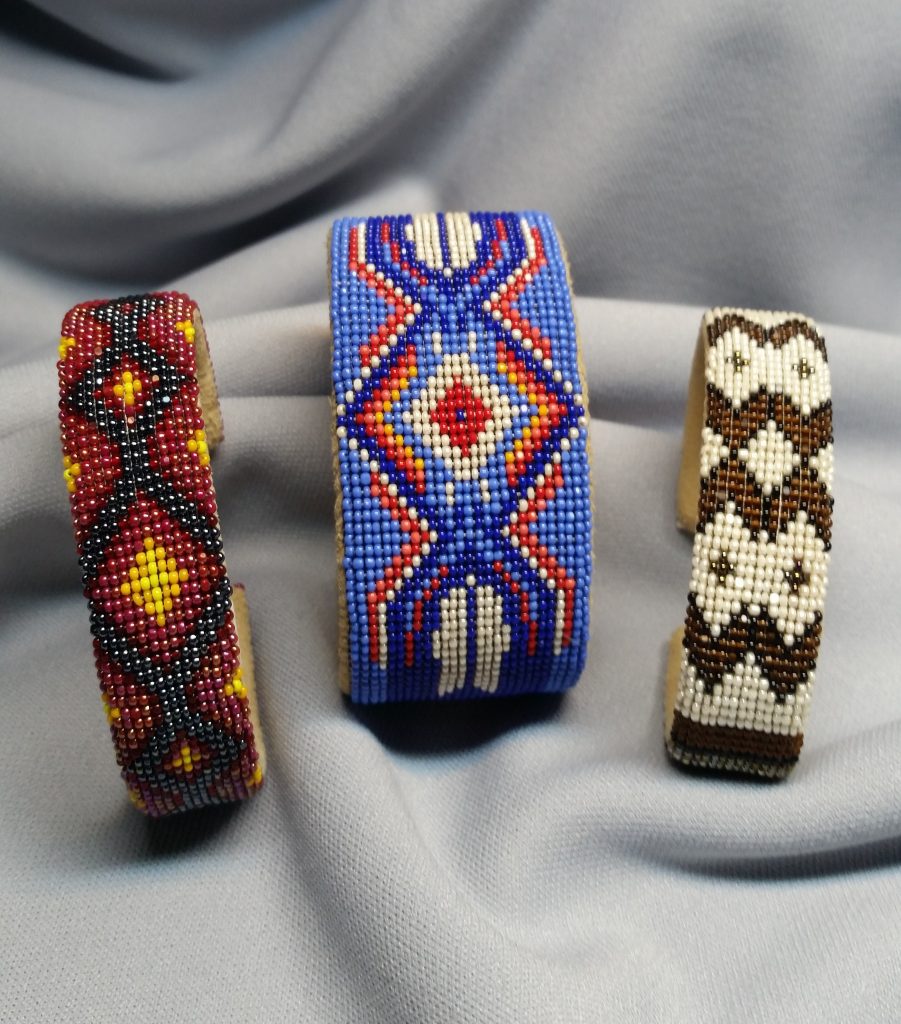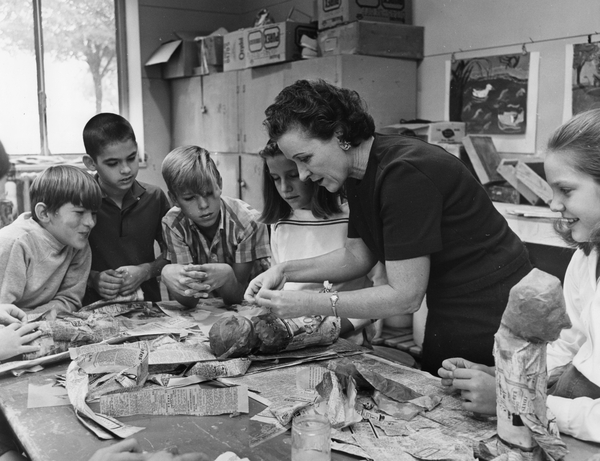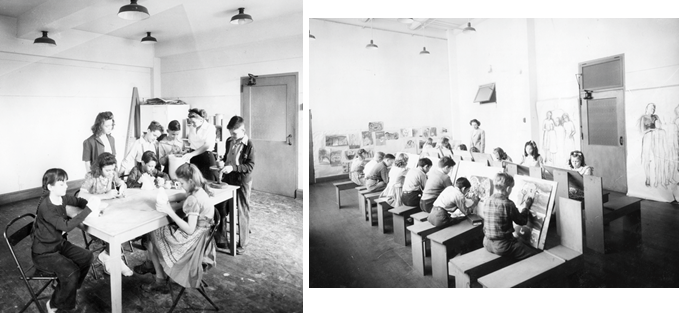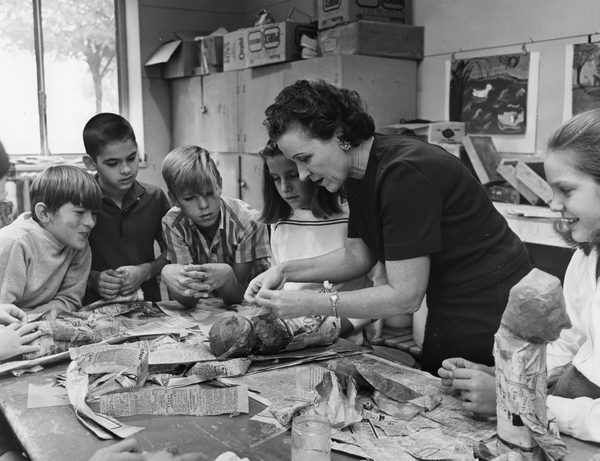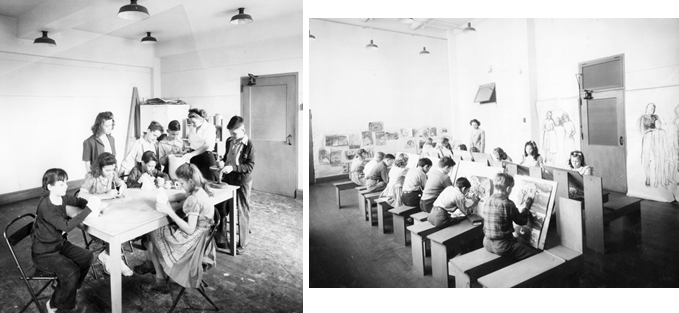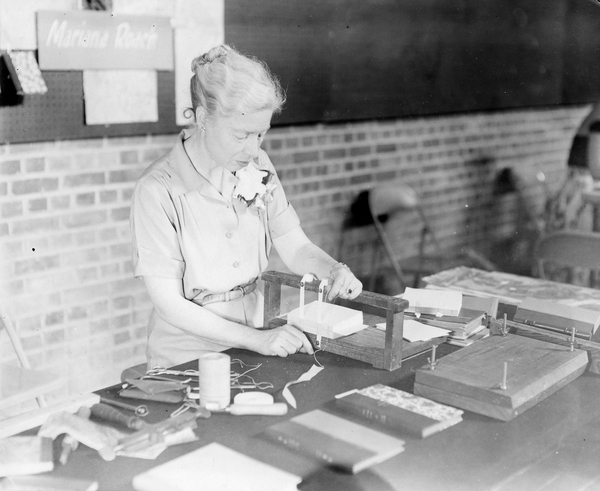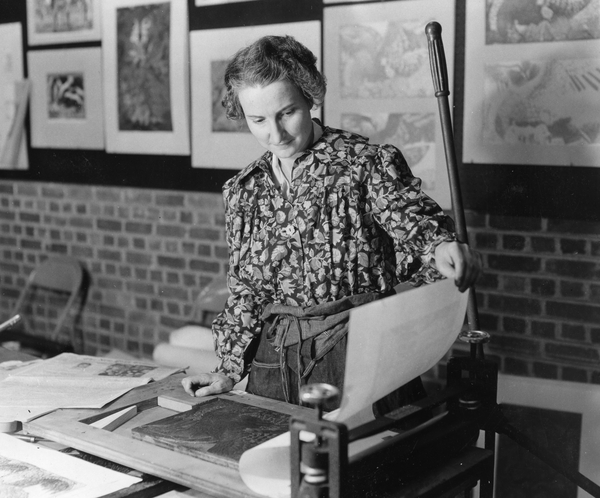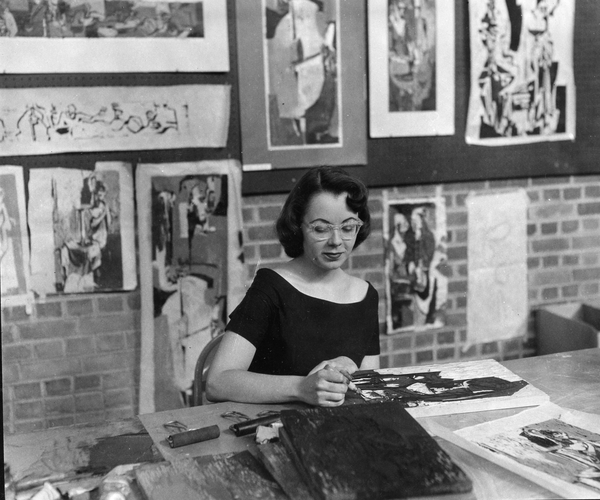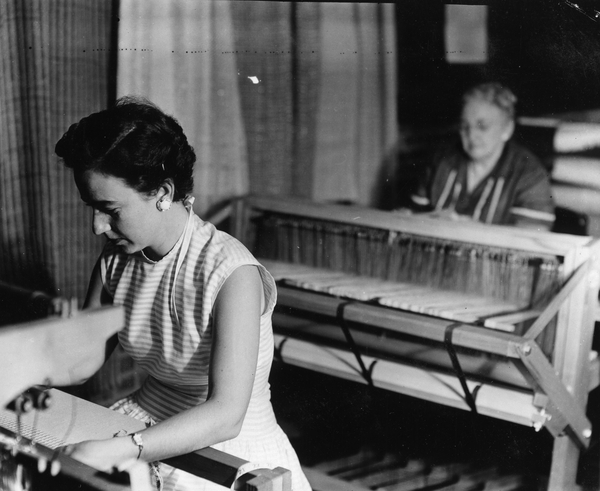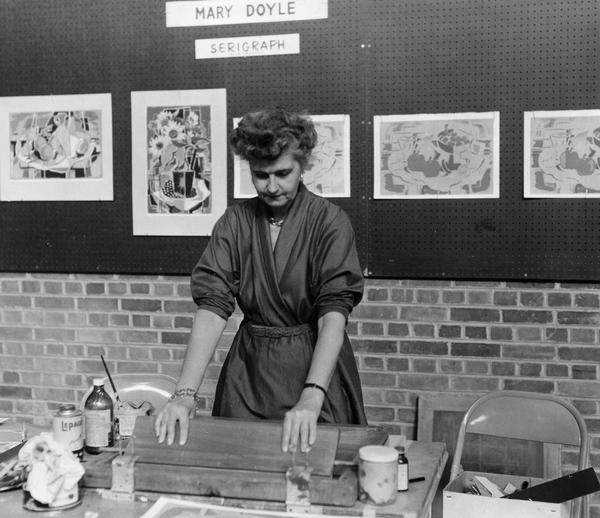We honored the opening of Spirit Lodge: Mississippian Art from Spiro with a night of artist demonstrations, performances, art making, and more. See how we celebrated at Late Night in this slideshow, and visit Spirit Lodge for free now through August 7!
Archive for March, 2022
Late Night Recap: Celebrating “Spirit Lodge”
Published March 29, 2022 Uncategorized ClosedTags: Late Night, Spirit Lodge
Expanded for DMA Members: Late Night Recap: Celebrating “Spirit Lodge”
Published March 29, 2022 Uncategorized ClosedTags: Late Night, Spirit Lodge
We honored the opening of Spirit Lodge: Mississippian Art from Spiro with a night of artist demonstrations, performances, art making, and more. See how we celebrated at Late Night in this slideshow, and visit Spirit Lodge for free now through August 7!
It’s All in the Family: The Earles in “Spirit Lodge”
Published March 23, 2022 Dallas , DFW , Exhibitions , works of art 1 CommentTags: Art, Caddo, Caddo art, Dallas Museum of Art, DMA
For over a thousand years, Caddo peoples lived, traded goods, made art, and grew crops in communities clustered around rivers in present-day Texas, Louisiana, Arkansas, and Oklahoma. They, like other Mississippian peoples, constructed earthen mounds that marked and shaped their landscape for political and ceremonial purposes. You can visit and learn more about three of those mounds at the Caddo Mounds State Historic Site in East Texas.
Colonization and colonialism dealt blow after blow to the Caddo, with epidemic diseases, forced removals to reservations, and the boarding school system all threatening the continuation of knowledge within Caddo communities. Many traditions survived through the concerted efforts of Caddo knowledge keepers, and others, though disrupted, have now been revived and revitalized through the work of contemporary artists and other cultural practitioners.
Among those artists are brothers Chad “Nish” Earles and Chase Kahwinhut Earles and their father, Wayne “Tay Sha” Earles, all of whom have artworks featured in Spirit Lodge: Mississippian Art from Spiro (on view through August 7, 2022).
Academic and professional experience in art and graphic design, a background in graffiti art, and deep engagement with Caddo history and traditions have all shaped Chad’s art. These varied influences are visible in his piece in Spirit Lodge, Tah-Nah-Hah “Buffalo,” a hand-painted skateboard deck featuring his characteristic bold lines and creative use of negative space.

Chase’s Batah Kuhuh alligator gar fish effigy bottle, acquired by the DMA in 2020, welcomes visitors into the exhibition. After its acquisition, Chase and Dr. Michelle Rich, the DMA’s Ellen and Harry S. Parker III Assistant Curator of the Arts of the Americas, had a conversation about his ceramic practice, which can be found here.
When you enter Spirit Lodge’s galleries, you’ll find not one, not two, but three additional works by Chase—two more of his ceramic vessels and one collaboration with Muscogee painter Starr Hardridge. The intricately incised designs on many of Chase’s pieces, as seen on Deé-Tumbah Kah’-Wis above, reflect his own spin on motifs used by pre-contact Caddo potters. Jeri Redcorn, the Caddo pottery revivalist, helped him start working in uniquely Caddo styles.
Inspiration isn’t only flowing from the older generations to the younger though—while Wayne had loved art since he was a child, his interest in stone carving was sparked by going to art shows with his sons (and some encouragement from Chase and Chad!). The stunning ceremonial weaponry featured in the exhibition is a testament to his rapid mastery of the art form. And there’s an extra layer of family connections—Wayne’s ceremonial mace shares a title with Chad’s skateboard deck, and his monolithic axe—like Chase’s effigy bottle—is in the shape of a gar fish.

Right: Monolithic axe (P-i-ta-u-ni-wan’-ha—To Have Power), Wayne “Tay Sha” Earles, Caddo, 2018. Stone. National Cowboy & Western Heritage Museum, 2019.34.2
Join us for the Late Night event on March 25 to see Chad along with the Caddo Culture Club exhibiting traditional Caddo dances, Chase demonstrating his potting, and many other artists and knowledge keepers sharing their expertise. And of course, come experience the Earles family’s incredible art in person in Spirit Lodge: Mississippian Art from Spiro!
Becca Merriman-Goldring is the McDermott Intern for Arts of the Americas at the DMA.
Behind the Scenes: Installing Senga Nengudi’s “Water Composition I”
Published March 22, 2022 Behind-the-Scenes , Conservation , Contemporary Art , Exhibitions , Staff , works of art ClosedTags: Art, Dallas Museum of Art, DMA
Influenced by Black cultural traditions and Japanese Gutai, artist Senga Nengudi’s work synthesizes multiple ideas circulating in the 1960s and 1970s: feminist practice, the role of materiality, and the relationship between activation, viewership, and performance. In her sculpture Water Composition I, currently on view in Slip Zone, Nengudi encloses colored water in plastic, creating a body-like form.
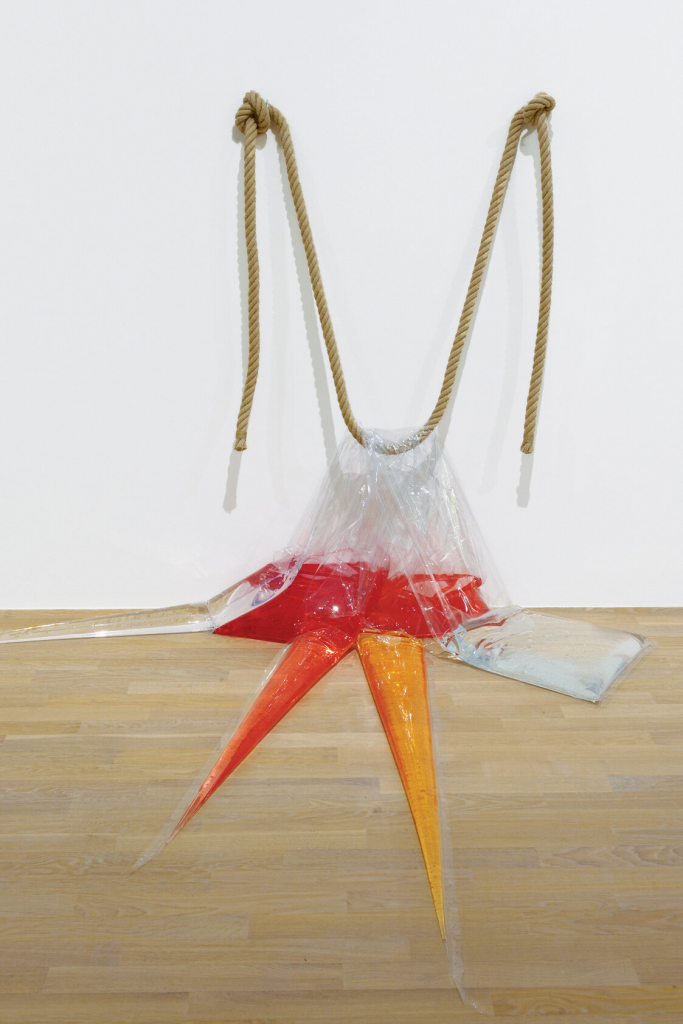
We asked Senior Preparator and IPM Coordinator Mary Nicolett what stood out to her about her experience installing this abstract work. Here’s what she had to say:
First priority upon being approached to work with Fran Baas, Interim Chief Conservator, on the Nengudi was sourcing two 2-gallon jugs for filling the piece.
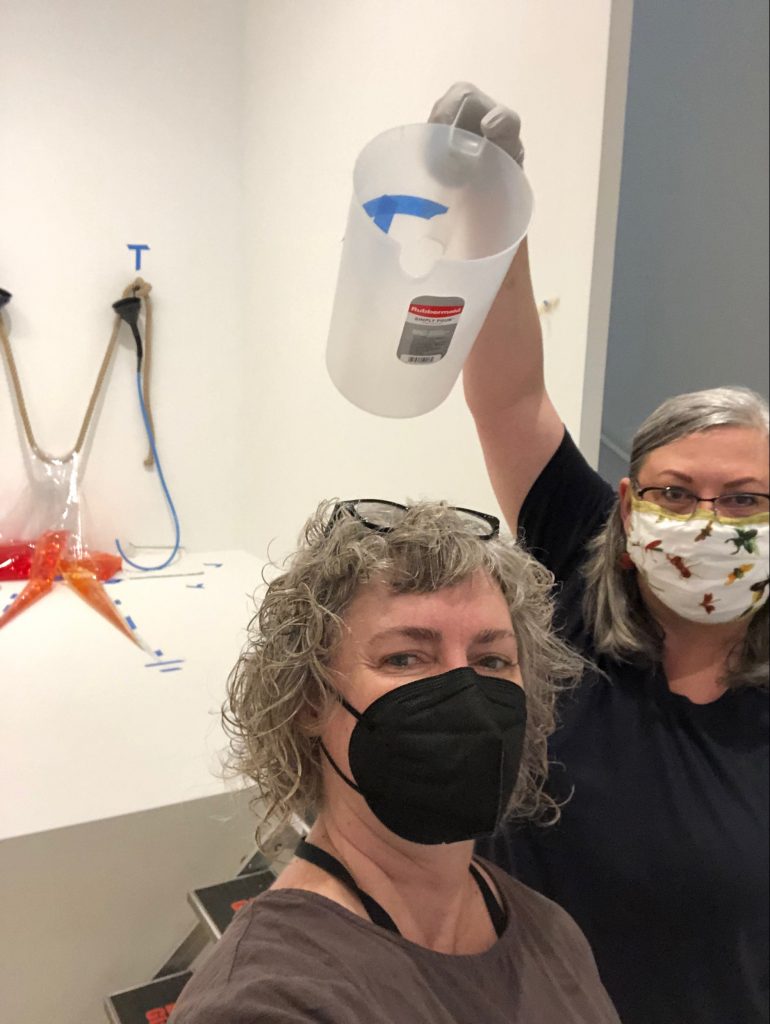
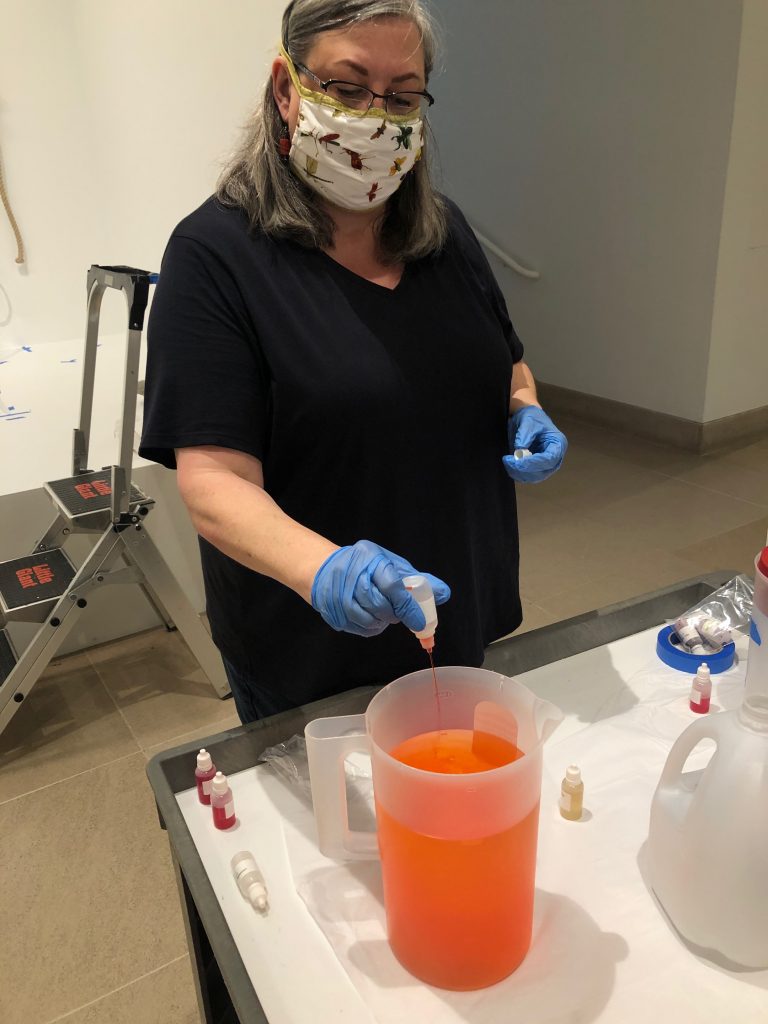
Once that had been done, we set about opening the contents of the packing tube. There I found a beautiful rope, tubing and funnels, pre-filled dye containers with pre-measured amounts, and of course the plastic “bags.” Also included, and very important, was the template for placement! We were able to figure out exactly where on the platform the piece would go, and it detailed the exact pinpointed location of each PVC bag including position of the heat-sealed-seam.
It took a while to truly understand the tubing and funnel system. What I wasn’t prepared for was how exquisitely this PVC bags where packed, in order of installation, one by one. Preparators often wish for things to be packed better, but this was a thing of beauty!
Fran and I set about the morning hooking the tubes into each bag and filling with the prescribed amount of dye mixed with the prescribed ionized distilled water. It was “slow and steady wins the race” and we did not spill a drop! Each funnel was marked with tape on the wall, as to which bag the tube went to, just to avoid any possible confusion.
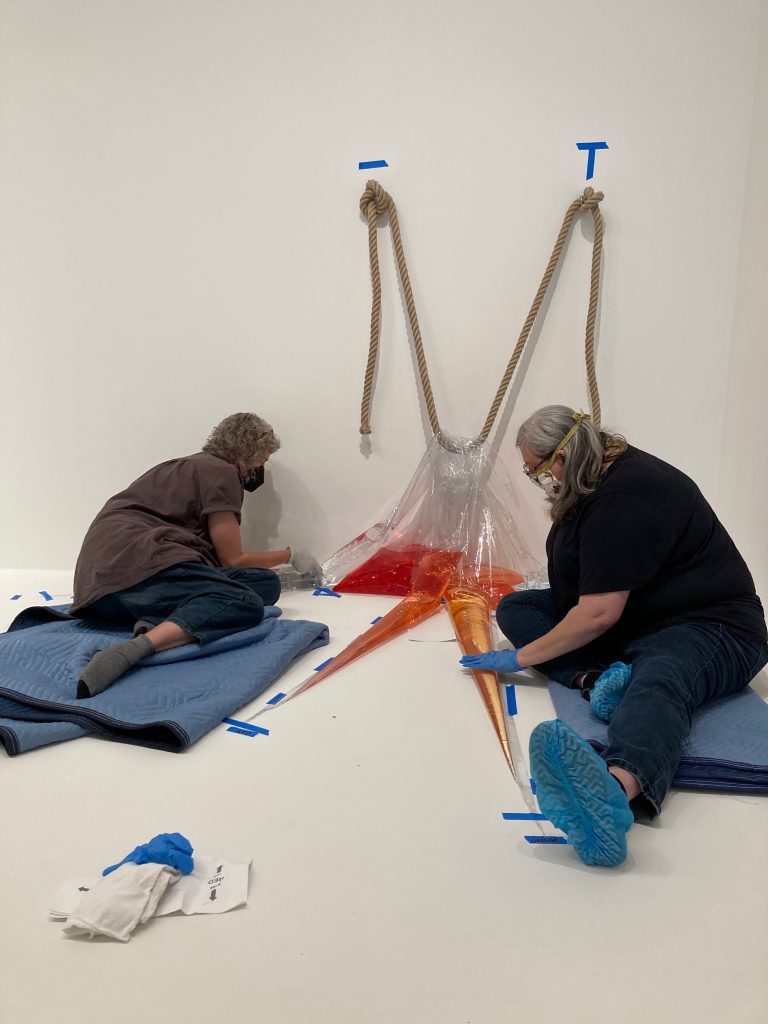
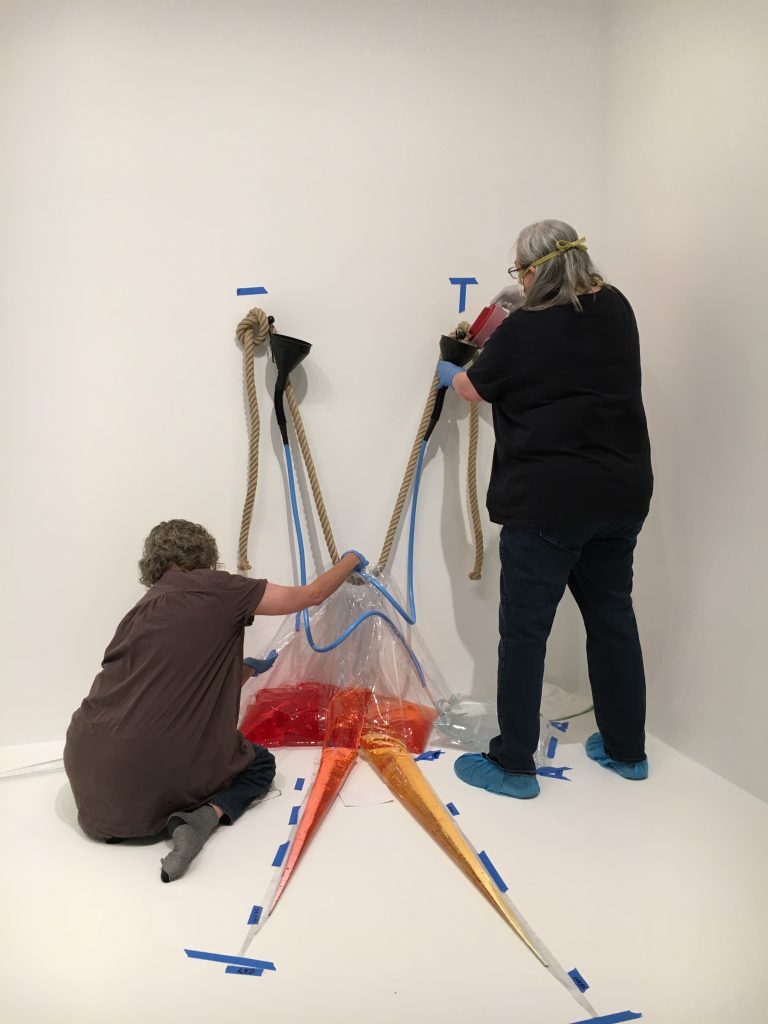
After all the bags were filled, Fran and I began removing bubbles in the bags by gently thumping each bag until the bubbles moved to the top.
A bit of tape removal, sweeping, touch-up paint, and we were done! And it looks marvelous!
Come see this work for yourself in the free exhibition Slip Zone: A New Look at Postwar Abstraction in the Americas and East Asia, on view now through July 10, 2022.
Mary Nicolett is the Senior Preparator and IPM Coordinator at the DMA.
Q&A with Yonavea Hawkins, Caddo Beadwork Artist
Published March 21, 2022 Dallas , Guest Blog Post , Late Nights , works of art ClosedTags: Art, Artist, Artist Interview, Beadwork, Caddo, Dallas Museum of Art, DMA
Yonavea Hawkins is an artist who creates intricate beadwork for Native American and Caddo cultural items. We are delighted to have her participate in the upcoming Late Night celebrating the new exhibition Spirit Lodge: Mississippian Art from Spiro, during which she will showcase several of her pieces and talk about her process and the connection between traditional and contemporary beadworking. Read our special Q&A with her to learn more about her practice ahead of the event on March 25!
How did you begin creating art?
As a child I was always drawing and painting, with art class in school being my favorite subject, then to obtaining a fine arts degree from Oklahoma City University and started working as a graphic designer. Eventually my 8 to 5 creative jobs morphed into print quality control with organized paperwork of meeting deadlines and budgets. Then and now with a full-time job, evenings and weekends are my creative times. Working from a small desk, my present work evolved from learning to sew and bead to make Caddo regalia for myself, my children, and then Native American regalia for others. Now I create a variety of bead work, cultural items, or diverse art with different beading techniques for juried art markets with competitions. Changing from pencil and paint to beads and buckskin became new mediums to work in and another way to express myself creatively.
The words “contemporary” and “traditional” carry a lot of weight when describing Indigenous arts. Where do you situate your work?
For my work it’s a combination of contemporary and traditional because of the materials used and the design elements, to the construction of the finished work. Contemporary because of the use of the current Charlotte bead colors and todays materials to bead on. Traditional, when I find the materials online to buy as I am an urban Native American without access to harvest and collect traditional materials once used. The use of glass bead work starts from European contact as beads, wool and silk were trade goods to Indigenous peoples, and these trade goods became traditional for some Indigenous peoples. Beading techniques developed for using trade beads and used today holds the traditional look, but in contemporary colors and designs, unless you find a stash of antique beads.
Tell us about some of the work you’re showing at DMA’s Late Night.
Several years back, a collector of my art told me that my beadwork was “Wearable Art”. As such a great deal of my work created for art markets are bracelet cuffs, contemporary beaded belts, belt buckles, hair barrettes, necklaces, and hatbands. After attending an art market, I never know what work will sell out and what I will be creating next, but I plan to show a variety of pieces mentioned earlier. I will also show cultural items that have won awards at art markets such as moccasins, turtle shell purses, bandolier bags, and pipe bags.
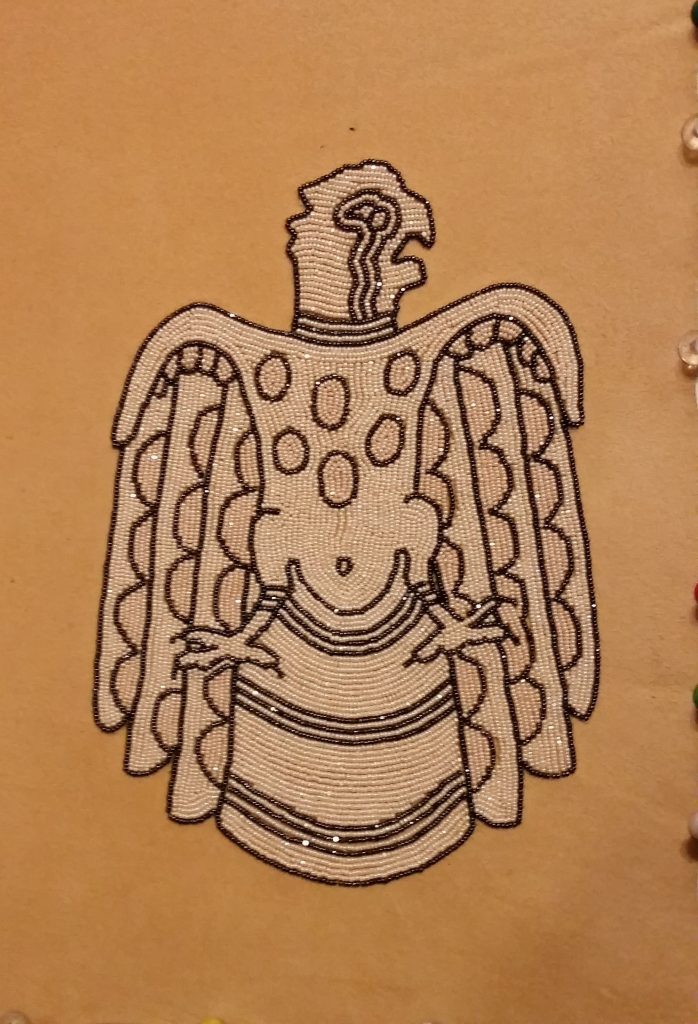
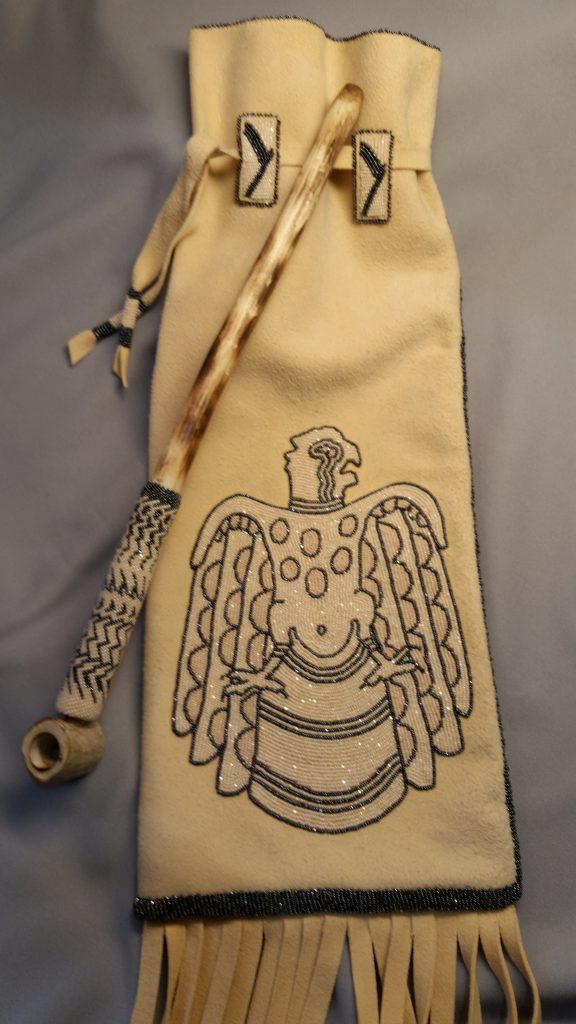
________
You can find out more about Yonavea Hawkins in this recent artist interview. Don’t miss out on our Late Night celebration on March 25, featuring artist demonstrations, art making, performances, films, and talks about the exhibition Spirit Lodge: Mississippian Art from Spiro, and more! Get tickets here.
Expanded for DMA Members: Q&A with Yonavea Hawkins
Published March 16, 2022 Exhibitions , Guest Blog Post , Late Nights , works of art ClosedTags: Dallas Museum of Art, DMA
Yonavea Hawkins is an artist who creates intricate beadwork for Native American and Caddo cultural items. We are delighted to have her participate in the upcoming Late Night celebrating the new exhibition Spirit Lodge: Mississippian Art from Spiro, during which she will showcase several of her pieces and talk about her process and the connection between traditional and contemporary beadworking. Read our special Q&A with her to learn more about her practice ahead of the event on March 25!
How did you begin creating art?
As a child I was always drawing and painting, with art class in school being my favorite subject, then to obtaining a fine arts degree from Oklahoma City University and started working as a graphic designer. Eventually my 8 to 5 creative jobs morphed into print quality control with organized paperwork of meeting deadlines and budgets. Then and now with a full-time job, evenings and weekends are my creative times. Working from a small desk, my present work evolved from learning to sew and bead to make Caddo regalia for myself, my children, and then Native American regalia for others. Now I create a variety of bead work, cultural items, or diverse art with different beading techniques for juried art markets with competitions. Changing from pencil and paint to beads and buckskin became new mediums to work in and another way to express myself creatively.
What makes working with beads special?
It’s the tactile experience of being able to stroke your fingers across a piece of finished beadwork or to pick it up and hold it. Buyers looking at my work will lightly run their fingers across a strip of beadwork and without hesitation others will pick up a piece to examine it closer and to hold it. Work created with Charlotte glass beads are visually appealing with the sparkle coming from the cut sides and with an iris shimmer. Though I do like the one bead at a time challenge to reach a completed work.
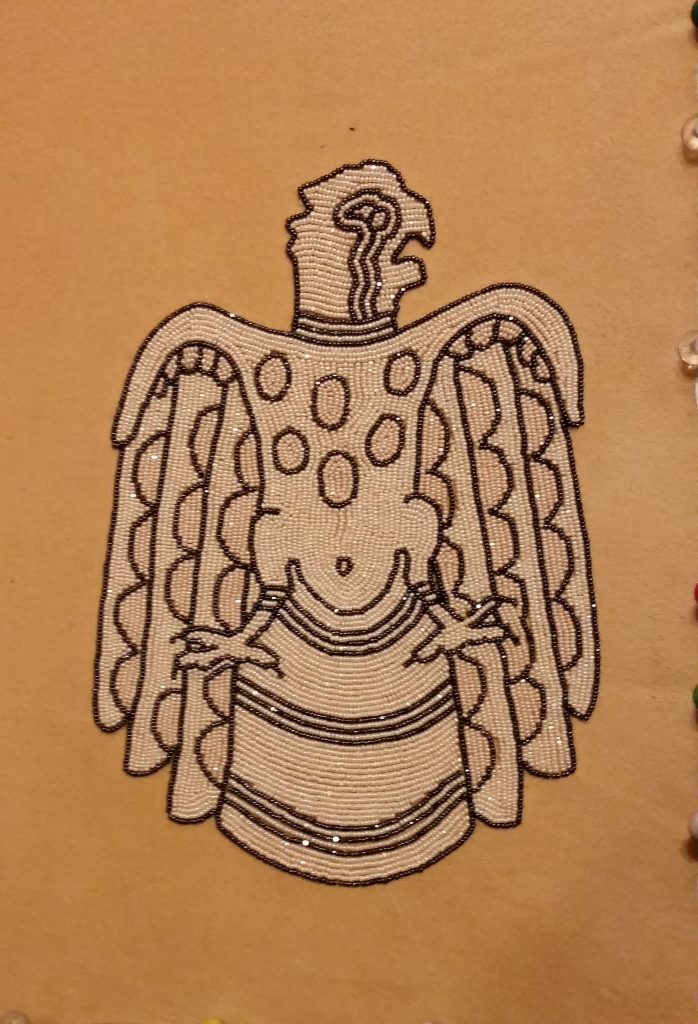
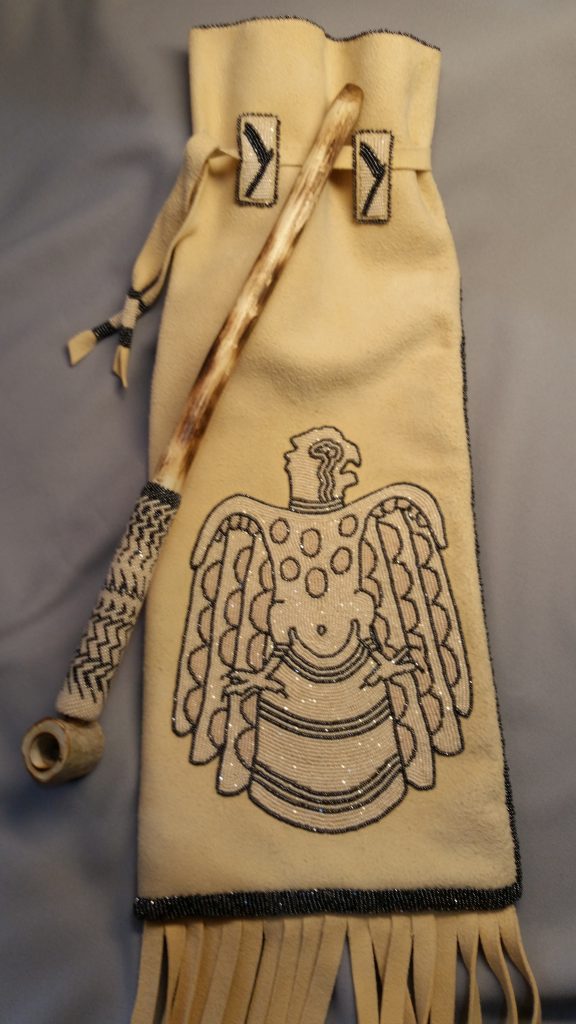
The words “contemporary” and “traditional” carry a lot of weight when describing Indigenous arts. Where do you situate your work?
For my work it’s a combination of contemporary and traditional because of the materials used and the design elements, to the construction of the finished work. Contemporary because of the use of the current Charlotte bead colors and todays materials to bead on. Traditional, when I find the materials online to buy as I am an urban Native American without access to harvest and collect traditional materials once used. The use of glass bead work starts from European contact as beads, wool and silk were trade goods to Indigenous peoples, and these trade goods became traditional for some Indigenous peoples. Beading techniques developed for using trade beads and used today holds the traditional look, but in contemporary colors and designs, unless you find a stash of antique beads.
Tell us about some of the work you’re showing at DMA’s Late Night.
Several years back, a collector of my art told me that my beadwork was “Wearable Art”. As such a great deal of my work created for art markets are bracelet cuffs, contemporary beaded belts, belt buckles, hair barrettes, necklaces, and hatbands. After attending an art market, I never know what work will sell out and what I will be creating next, but I plan to show a variety of pieces mentioned earlier. I will also show cultural items that have won awards at art markets such as moccasins, turtle shell purses, bandolier bags, and pipe bags.
________
You can find out more about Yonavea Hawkins in this recent artist interview. Don’t miss out on our Late Night celebration on March 25, featuring artist demonstrations, art making, performances, films, and talks about the exhibition Spirit Lodge: Mississippian Art from Spiro, and more! Get tickets here.
The Women of the Museum School
Published March 3, 2022 Archive ClosedTags: Dallas Museum of Art, DMA
Arts education has been an important feature of the museum since its founding in 1903. The Dallas Art Association held lecture series and programs featuring the artists, collectors, and art historians of the day to educate members on art and to promote collecting. After the first professional director was hired in 1929, the adult education offerings expanded to include director-led art history lecture series and gallery talks.
Educational offerings were extended to children in 1937 when Director Richard Foster Howard started the school tour program with the Dallas Independent School District and a program of free Saturday art classes for children. By 1940, Maggie Joe Hogue, first head of the education department, reported that the DMFA’s education programs were unique in that they focused on creative teaching where most other museums confine their teaching to appreciation.
The creative teaching element was formalized with the founding of the Museum School in 1941, which offered a variety of art classes for children and adults. A number of well-known Dallas artists taught at the Museum School including Octavio Medellin (see exhibition and library case), Otis Dozier, Merritt Mauzey, and Roger Winter. But as this is Women’s History Month, let’s focus on a few of the women artists who taught at the Museum School.
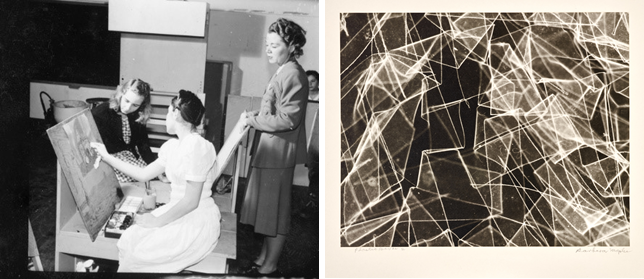
Right: Barbara Maples, Plastic Boxes 2, c. 1967–1968, gelatin silver print, Dallas Museum of Art, Texas Artists Fund, 2009.5
Barbara Maples (1912-1999) was painter, printmaker, photographer and educator. She began her career teaching elementary and secondary art for the Dallas Independent School District from 1937-1964, and concurrently taught children’s classes at the Museum School from 1940-1954. She went on to become Professor and Head of the Department of Art Education at Southern Methodist University from 1965-1978. Maples had three one-person exhibitions at the DMFA in 1941, 1944 and 1947, in addition to having her works selected for or included in at least 38 exhibitions at the museum. Three prints and one photograph are in the permanent collection.
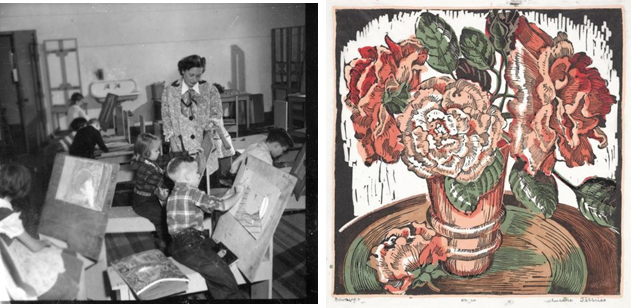
Right: Lucille Jeffries, Bouquet, n.d., color linoleum cut, Dallas Museum of Art, gift of Mrs. C.P. Wright, 1964.65
Lucille Jeffries (1903-1950) was a painter and graphic designer. She taught children’s classes at the Museum School in the 1940s, while also teaching at Mt. Auburn School in Dallas. She also had three one-person exhibitions at the DMFA in 1941, 1943, and 1947, and had work included in over 25 juried or group exhibitions. Twenty-five of her lithographs, watercolors and linoleum cuts are in the permanent collection.
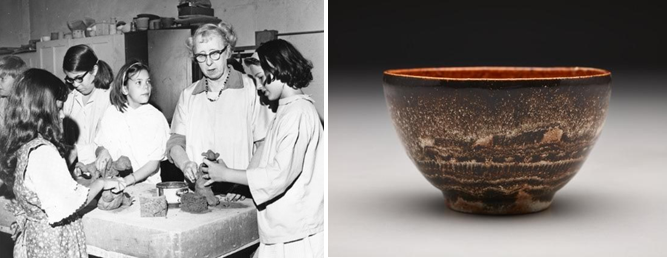
Right: Evaline Sellors, Bowl, c. 1951, glazed stoneware, Dallas Museum of Art, gift of the Craft Guild of Dallas, 1951.65
Evaline Sellors (1907-1995) taught adult pottery and ceramic sculpture classes at the Museum School in partnership with the Craft Guild of Dallas from 1950-1968. She also taught children’s classes at the Fort Worth Art Center, and designed costumes and puppets. Her work was included in over 20 juried exhibitions held at the DMFA and was featured in an exhibition of Fort Worth artists with two others in 1934. Two works by Sellors are included in the DMA’s permanent collection.
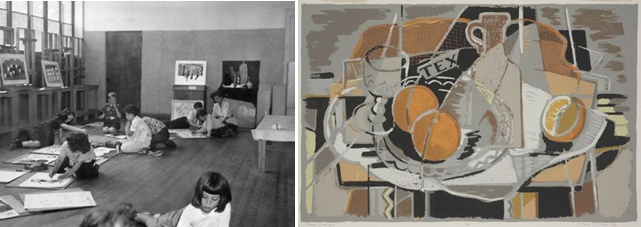
Right: Mary Doyle, Texas Oranges, 1953, serigraph, Dallas Museum of Art, gift of the artist, 1954.3
Mary Doyle (1904-2000) was a printmaker, painter and watercolorist, but her favorite mediums were serigraphy and silk screen. Doyle taught children’s painting classes at the Museum School from the 1940s-1960s, later joining the museum full time as Education Director and Registrar. She also taught art for the Dallas Independent School District from 1935-1972. Doyle had work selected for 10 juried exhibitions held at the DMFA, and two works in the permanent collection.
These are just three of the many women who taught at the Museum School from 1941 to its closure in 1970. Others include: Eloise Blondel, Dorothy Brake, Caroline Daniel, Ellen Dennis, Carolyn Dodson, Sybil Edwards, Patsy Eldridge, Ann Cushing Gantz, Estella Henkel, Wanda Hill, Margaret Hull, Frances Jenkins, Annelies Kahn, Dorothy Kay King, Rita Mallett, Virginia Oechsner, Martha Jane Reed, Coreen Spellman, Jane Stare, Ruth Tears, and Peggy Wilson.
Hillary Bober is the Archivist at the Dallas Museum of Art.
Arts education has been an important feature of the museum since its founding in 1903. The Dallas Art Association held lecture series and programs featuring the artists, collectors, and art historians of the day to educate members on art and to promote collecting. After the first professional director was hired in 1929, the adult education offerings expanded to include director-led art history lecture series and gallery talks.
Educational offerings were extended to children in 1937 when Director Richard Foster Howard started the school tour program with the Dallas Independent School District and a program of free Saturday art classes for children. By 1940, Maggie Joe Hogue, first head of the education department, reported that the DMFA’s education programs were unique in that they focused on creative teaching where most other museums confine their teaching to appreciation.
The creative teaching element was formalized with the founding of the Museum School in 1941, which offered a variety of art classes for children and adults. A number of well-known Dallas artists taught at the Museum School including Octavio Medellin (see exhibition and library case), Otis Dozier, Merritt Mauzey, and Roger Winter. But as this is Women’s History Month, let’s focus on a few of the women artists who taught at the Museum School.
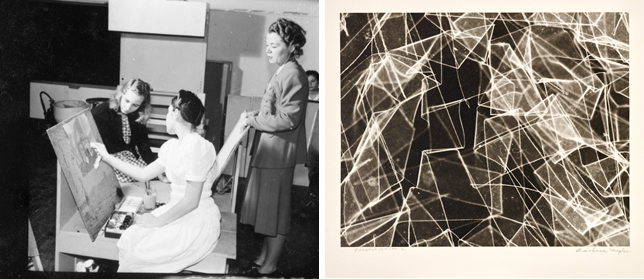
Right: Barbara Maples, Plastic Boxes 2, c. 1967–1968, gelatin silver print, Dallas Museum of Art, Texas Artists Fund, 2009.5
Barbara Maples (1912-1999) was painter, printmaker, photographer and educator. She began her career teaching elementary and secondary art for the Dallas Independent School District from 1937-1964, and concurrently taught children’s classes at the Museum School from 1940-1954. She went on to become Professor and Head of the Department of Art Education at Southern Methodist University from 1965-1978. Maples had three one-person exhibitions at the DMFA in 1941, 1944 and 1947, in addition to having her works selected for or included in at least 38 exhibitions at the museum. Three prints and one photograph are in the permanent collection.
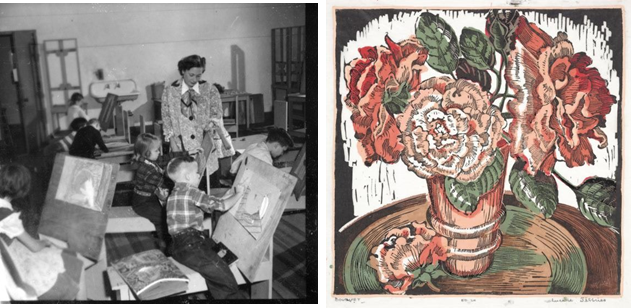
Right: Lucille Jeffries, Bouquet, n.d., color linoleum cut, Dallas Museum of Art, gift of Mrs. C.P. Wright, 1964.65
Lucille Jeffries (1903-1950) was a painter and graphic designer. She taught children’s classes at the Museum School in the 1940s, while also teaching at Mt. Auburn School in Dallas. She also had three one-person exhibitions at the DMFA in 1941, 1943, and 1947, and had work included in over 25 juried or group exhibitions. Twenty-five of her lithographs, watercolors and linoleum cuts are in the permanent collection.
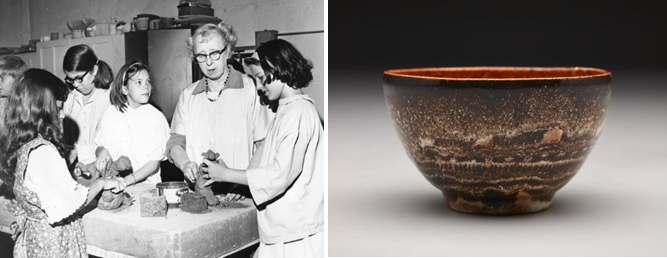
Right: Evaline Sellors, Bowl, c. 1951, glazed stoneware, Dallas Museum of Art, gift of the Craft Guild of Dallas, 1951.65
Evaline Sellors (1907-1995) taught adult pottery and ceramic sculpture classes at the Museum School in partnership with the Craft Guild of Dallas from 1950-1968. She also taught children’s classes at the Fort Worth Art Center, and designed costumes and puppets. Her work was included in over 20 juried exhibitions held at the DMFA and was featured in an exhibition of Fort Worth artists with two others in 1934. Two works by Sellors are included in the DMA’s permanent collection.
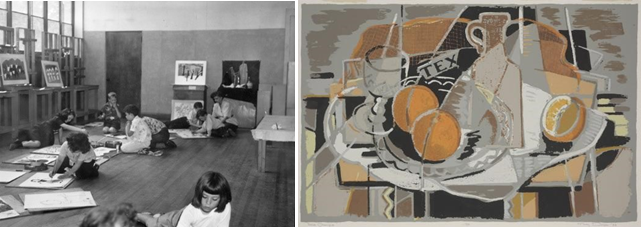
Right: Mary Doyle, Texas Oranges, 1953, serigraph, Dallas Museum of Art, gift of the artist, 1954.3
Mary Doyle (1904-2000) was a printmaker, painter and watercolorist, but her favorite mediums were serigraphy and silk screen. Doyle taught children’s painting classes at the Museum School from the 1940s-1960s, later joining the museum full time as Education Director and Registrar. She also taught art for the Dallas Independent School District from 1935-1972. Doyle had work selected for 10 juried exhibitions held at the DMFA, and two works in the permanent collection.
These are just three of the many women who taught at the Museum School from 1941 to its closure in 1970. Others include: Eloise Blondel, Dorothy Brake, Caroline Daniel, Ellen Dennis, Carolyn Dodson, Sybil Edwards, Patsy Eldridge, Ann Cushing Gantz, Estella Henkel, Wanda Hill, Margaret Hull, Frances Jenkins, Annelies Kahn, Dorothy Kay King, Rita Mallett, Virginia Oechsner, Martha Jane Reed, Coreen Spellman, Jane Stare, Ruth Tears, and Peggy Wilson.
In addition to classes, the museum held artist demonstrations daily for visitors to the State Fair of Texas in the early 1950s. The popular Art-in-Action program featured painters, sculptors, printmakers and potters demonstrating their professional talents. While the intent of the program was to fascinate visitors, it also promoted new enrollments for the Museum School and thus featured many Museum School teachers. Other artists who regularly submitted to the annual Dallas County Allied Arts, Texas General, Texas Crafts, and Southwestern Prints and Drawings exhibitions and had one-man exhibitions at the DMFA were also included on the roster of demonstrators.
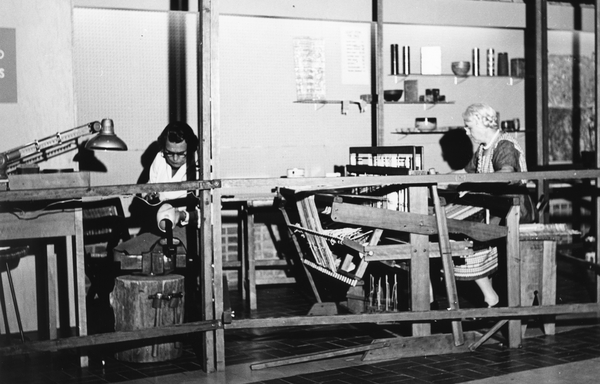
In May-June 1956 the museum revived the demonstrations with the Festival of Art in Action, a series of 4 Saturday-Sunday events with a different media each weekend: Crafts, Printmaking, Painting, and Sculpture.
Images above: Marianna Roach demonstrating bookbinding, Janet Turner demonstrating printmaking, Ann Cushing Gantz demonstrating painting, Estella Henkel demonstrating weaving, and Mary Doyle demonstrating serigraphy.
Many other women artists demonstrated their skill and talents in the Art-in-Action series in the 1950s including: Clara Miller & Nita Cisneros (kick wheel pottery); Sue Brown, Lani Robley, Becca Kennerly, Thelma Killian, Evaline Sellors (ceramics); Ann Truitt (sculpture), Blanche McVey (Etching); and Coreen Spellman, Elizabeth Walmsley, Constance Forsyth, Lea Cuilty (Printmaking).
Hillary Bober is the Archivist at the Dallas Museum of Art.
